
A TREE HOUSE CHAT WITH FARMER TRACY
09/03/20 — Ada Broussard
In case you missed it, last week we went to Garfield to catch up with Farmer Brenton, who has been focused on the farm’s battle with pigweed and our plan to tackle this pesky plant and ensure a healthy fall crop. This week, we met up with Farmer Tracy, the barn manager at our Hergotz Packing Shed, who, for the past few weeks has turned his attention to the here and now: what vegetables are currently thriving in the fields, how to get them harvested efficiently while maintaining the quality, and how to incorporate these exciting vegetables into our CSA Program and farmers’ market stalls.
We chatted with Tracy at the end of the day in Hergotz’s beloved tree house - a paradise Brenton built for his kids 10+ years ago, but has since been taken over by tired farmers looking for a playful spot to rest, and maybe slide, or zipline or swing. Tracy is our farm’s barn manager and his role is one of a master conductor. Here are some of the main operations Tracy helps to orchestrate: he contributes to crop planning, coordinates the daily harvest needs with Vicente, works with Vicente, Temo, Jack, and Brenton to keep an eye on the fields and progression of upcoming crops, works with Ricky and the barn crew to keep the cooler inventory accurate and updated, works with the CSA Packing Manager, Andrew, to plan and execute the weekly boxes, works with the wholesale, restaurants, and farmers’ market departments to determine and communicate what veggies they need from the fields, and when. Tracy also works with Krishna to troubleshoot staffing at the packing shed- making sure we have enough hands to make light-ish the work and also works with Faith to intercept any quality concerns from our CSA Program. If that sounds like a lot, it is. Despite this complex symphony of systems that Tracy keeps track of, his head always seems organized, and his message clear.
Here is what Farmer Tracy wants you to remember at this moment in the season.
![]() Tracy, on the phone with the farm and likely signaling to a driver that he's successfully backed up the reefer tuck to the loading dock. Photo by Scott David Gordon.
Tracy, on the phone with the farm and likely signaling to a driver that he's successfully backed up the reefer tuck to the loading dock. Photo by Scott David Gordon.
ONE: WINTER IS COMING.
We know that at this point in the summer season, it can be easy to grow fatigued by seemingly endless okra and eggplant (we’ve got recipes for that!). If you’ve been outside between the hours of 9am and 6 pm, you’re no doubt aware that it’s hot outside. The truth is, summer is the hardest season for our farm. There are only a limited number of crops that can stand up to the sometimes oppressive temperatures, and we’re growing just about all of them!
Farmer Tracy has a great perspective on this late summer monotony: “It might take you a few months into the CSA to really feel this way, but the feeling of drudgery is one of the beautiful things, I think, about the program. There is the time of anticipation which is the same that we, as farmers, experience - we’re anticipating what crops are going to come of our work. And then there is the point in the growing season when all the box contents all feel like a breath of fresh air, the boxes are full of very high-quality stuff... And then there is a period of drudgery and monotony. And I don’t mean it in such a negative sense. But even as farmers…. like, man, it’s SO hot… we’ve been doing this every day, in the heat… or maybe it’s really cold… and that work can feel like drudgery, too. And the customers are sharing this experience with us and that makes us connected in a way... And it's a circle that keeps going around, with the seasons. And rather than going to a place of pure boredom and drudgery, and least you can ride the rollercoaster right round, baby, right round.”
The take-home message from Farmer Tracy? Cool-season crops are on their way, in fact, they’re beginning to trickle in, and before you know it you’ll be drowning in kale and dreaming of earthy eggplant.
![]() Baby bok choy, mustard, turnips, and arugula: just some of the cool-season crops that are trickling into CSA boxes and market stands, alike. Photo by Scott David Gordon
Baby bok choy, mustard, turnips, and arugula: just some of the cool-season crops that are trickling into CSA boxes and market stands, alike. Photo by Scott David Gordon
TWO: BELIEVE US: WE’RE DOING EVERYTHING WE CAN TO BRING YOU VARIETY
If you’re a locavore or home gardener who truly has a pulse on what is possible in the summer months, you may have noticed some surprisingly green guests in your CSA box these past few weeks. Arugula, bok choy, and mustard greens have made their late August, early-September debut in CSA boxes and market stands, alike. The journey of these leafy greens, however, was anything but simple. We are constantly testing the limits of planting windows, always with the goal to maybe, just maybe, bring you tomatoes in May or arugula in early September. Often, we don’t count on these plantings and view their potential success as somewhat experimental.
A week or so ago, it was a miraculous sight to see beds blanketed in bright green arugula, bok choy, and mustards. But it shouldn’t have been too much of a surprise - when we planted these greens, there was a concerted effort on the farm to keep a close eye on these crops, adjust watering schedules if needed, and keep the weeds at bay. This effort paid off, and we had succeeded in growing a successful crop on the fridge of a season! But, that was just part one in getting these crops into your kitchen. Tracy tells me the story of the bok choy: “We all agreed that if we were going to plant these things early, we’d have to adjust our harvest schedule a bit to accommodate for these more delicate crops being ready in the middle of the summer. They can’t be harvested and spend any time in the sun… I mean, it’s over 100 degrees almost every day, and it’s in the 90s by 8 or 9 in the morning. When are we going to harvest them? It can’t spend any time in the field (after it’s picked) or it will be toast. So we had to switch the schedule up - rather than harvesting squash first in the morning, we’d harvest the greens first thing while it’s still cool outside.” Harvesting bok choy early in the morning (at sunrise!) before harvesting squash may sound like a simple adjustment, but this one change can have ripple effects for our operation. For example, if squash was listed on the Whole Foods or Central Market distribution list for the day, the packing crew who meticulously puts these labor-intensive orders together would be behind schedule, waiting on squash.
![]() We know we've been talking about baby bok choy, but there are obviously some big boys, too. Photo by Scott David Gordon.
We know we've been talking about baby bok choy, but there are obviously some big boys, too. Photo by Scott David Gordon.
There are more adjustments that have to happen in the fields to make this bok choy, for example, happen, “To harvest this stuff and be happy with the quality, we had to make sure we had tractors and trailers out in the fields waiting for the harvest to be complete so that the second it was done, it was being trucked to the coolers.” Other summer crops like squash and melons can withstand a little bit of time in the sun, and our harvest crew can simply stack full bins near the end of the rows, and a tractor can scoop them up when it’s available. But for a leafy green like bok choy, it truly must be put in the cooler moments after it’s cut from the ground, else customers would be receiving pre-cooked baby bok choy, and we’re not really a meal-delivery company.
Once bok choy arrives at our packing shed, these tiny stalks are immediately dunked in cold water to remove the field heat. After a cool dunk, the bok choy is stored in the cooler, where we now pack our CSA shares, and remains in this cooler until it's transported to your doorstep or neighborhood. Tracy concludes the bok choy backstory by reiterating the whole-farm effort necessary to get an edge on seasonality, “From beginning to end, we gotta have that circle of communication from the farm to the barn to make it happen.”
![]() Farmer Tracy going over some of the numbers for the day. Photo by Scott David Gordon.
Farmer Tracy going over some of the numbers for the day. Photo by Scott David Gordon.
WE PROMISE WE HAVE OUR REASONS
When chatting with Tracy about the beautiful bok choy, it was clear that making this particular harvest happen was a labor of love. An early-season gift from the JBG Farmers to our CSA Members, and a gift that we’re proud of and excited to produce! But remember how we mentioned that plantings like this are somewhat experimental? When planning out our CSA Box Contents for August and September, the sudden availability of baby bok choy, for example, wasn’t accounted for.
![]() CSA Shares ready for pickup at the Mueller Farmers Market last weekend. Photo by Scott David Gordon.
CSA Shares ready for pickup at the Mueller Farmers Market last weekend. Photo by Scott David Gordon.
Tracy reflects on the decision to include the bok choy, anyway: “Something Brenton said to me years ago was on my mind this week. He was kind of talking about his core beliefs and ideas about the CSA and said, ‘Tracy, if this is ready and this is ready… let’s harvest it!’ And I’m like, ‘Brenton, I know it’s ready, but what are we going to do with it if you harvest it? We’ve already planned out the CSA contents, and we’re several days into finalizing the logistics. We’d have to change the harvest schedule, update the website, and possibly deal with upset customers who are trying to meal plan.’ And Brenton responded, ‘I understand all of this and those are all important… but these crops are amazing! They’re the best we have to offer right now, and I really want the best of what we have to go into the CSA boxes regardless of when it becomes ready. I don’t want our CSA members to miss out.’”
Planning the box contents for so many families, the building blocks of their weekly meals, is something we take very seriously. We promise that if you ever receive something in your share that you weren’t expecting, it’s there for a reason and it’s something we thought long and hard about; we’re not switching veggies on a whim and are always trying to find a balance between delivering exactly what we said we would, and also making sure you don’t miss out on the firsts of the season. Plants don’t always grow like we think they will, and our farm systems (and CSA box contents) sometimes have to adjust accordingly.
![]() Dunked baby bok choy. Photo by Scott David Gordon.
Dunked baby bok choy. Photo by Scott David Gordon.
IN CONCLUSION
For years, we’ve grown, harvested, and packed for a pretty consistent number of CSA boxes. About 6 months ago, the number of CSA boxes we were packing on a daily basis doubled. Now, with a bit of distance from the 2020 March to remember, we’ve finally adjusted to this new volume, both from the planting and packing perspective. For those of you that may be new to the CSA, we want to thank you for supporting our local and organic farm! We know that making the shift to a more seasonally-focused diet can sometimes feel limiting compared to the endless isles of imported produce at the grocery store. You may wonder why one week you got huge honkers of sweet potatoes, and the next week you got a bundle of baby sweet potats. And the simple answer is beautiful - because they’re coming straight from the farm! Grocery stores have very strict size (and cosmetic) standards for the produce they’re willing to buy from farmers, but there are plenty of harvested crops that don’t qualify for that beauty pageant. As a member of our CSA Program, you are committing to supporting our whole farm and its whole harvest. You’ll start to notice how even the size of certain crops, like peppers, can change along with the season. Usually, at the beginning of the season when the plants are at their healthiest, peppers come in very large. The same pepper plant that produced ribbon-winning peppers at the beginning of the season will usually produce smaller peppers further into the summer. But Farmer Tracy wants to make sure you know that we’re always going to maintain the value of your CSA share and adjust for the changes in crop size. Smaller peppers in the field simply mean you get more peppers - equal to the volume of the early-season giants.
![]() Same potato crop, different sizing possibilities... all delicious and nutritious! Photo by Scott David Gordon
Same potato crop, different sizing possibilities... all delicious and nutritious! Photo by Scott David Gordon
Farmer Tracy is setting the tone for this seasonal shift, and we’re eager to follow along, “Fall is so close. It’s going to be one of the best. There’s no such thing as luck. It’s preparation meets opportunity. We’re so prepared, top down!” If you’ve made it to the bottom of this post, we just want to say thank you for following along. And also! If you’re a CSA Member, we’ve got a little secret to tell you: Customization is OPEN! We’re not quite ready to shout it from the rooftops, yet, but if you happen to be reading this discreet announcement we want you to log in to your account and customize to your heart’s desire. This somewhat secret and slow return of our customization feature will help our CSA crew adjust to this big change and work out any kinks. Thanks for your support along the way!
As always, thanks for reading. Have a happy Labor Day!
Love, Your Farmers
![]() Farmer Tracy and his two kids, Obi and Eden, at our Garfield Farm back in March of 2019. Photo by Scott David Gordon.
Farmer Tracy and his two kids, Obi and Eden, at our Garfield Farm back in March of 2019. Photo by Scott David Gordon.
We chatted with Tracy at the end of the day in Hergotz’s beloved tree house - a paradise Brenton built for his kids 10+ years ago, but has since been taken over by tired farmers looking for a playful spot to rest, and maybe slide, or zipline or swing. Tracy is our farm’s barn manager and his role is one of a master conductor. Here are some of the main operations Tracy helps to orchestrate: he contributes to crop planning, coordinates the daily harvest needs with Vicente, works with Vicente, Temo, Jack, and Brenton to keep an eye on the fields and progression of upcoming crops, works with Ricky and the barn crew to keep the cooler inventory accurate and updated, works with the CSA Packing Manager, Andrew, to plan and execute the weekly boxes, works with the wholesale, restaurants, and farmers’ market departments to determine and communicate what veggies they need from the fields, and when. Tracy also works with Krishna to troubleshoot staffing at the packing shed- making sure we have enough hands to make light-ish the work and also works with Faith to intercept any quality concerns from our CSA Program. If that sounds like a lot, it is. Despite this complex symphony of systems that Tracy keeps track of, his head always seems organized, and his message clear.
Here is what Farmer Tracy wants you to remember at this moment in the season.
 Tracy, on the phone with the farm and likely signaling to a driver that he's successfully backed up the reefer tuck to the loading dock. Photo by Scott David Gordon.
Tracy, on the phone with the farm and likely signaling to a driver that he's successfully backed up the reefer tuck to the loading dock. Photo by Scott David Gordon.
ONE: WINTER IS COMING.
We know that at this point in the summer season, it can be easy to grow fatigued by seemingly endless okra and eggplant (we’ve got recipes for that!). If you’ve been outside between the hours of 9am and 6 pm, you’re no doubt aware that it’s hot outside. The truth is, summer is the hardest season for our farm. There are only a limited number of crops that can stand up to the sometimes oppressive temperatures, and we’re growing just about all of them!
Farmer Tracy has a great perspective on this late summer monotony: “It might take you a few months into the CSA to really feel this way, but the feeling of drudgery is one of the beautiful things, I think, about the program. There is the time of anticipation which is the same that we, as farmers, experience - we’re anticipating what crops are going to come of our work. And then there is the point in the growing season when all the box contents all feel like a breath of fresh air, the boxes are full of very high-quality stuff... And then there is a period of drudgery and monotony. And I don’t mean it in such a negative sense. But even as farmers…. like, man, it’s SO hot… we’ve been doing this every day, in the heat… or maybe it’s really cold… and that work can feel like drudgery, too. And the customers are sharing this experience with us and that makes us connected in a way... And it's a circle that keeps going around, with the seasons. And rather than going to a place of pure boredom and drudgery, and least you can ride the rollercoaster right round, baby, right round.”
The take-home message from Farmer Tracy? Cool-season crops are on their way, in fact, they’re beginning to trickle in, and before you know it you’ll be drowning in kale and dreaming of earthy eggplant.
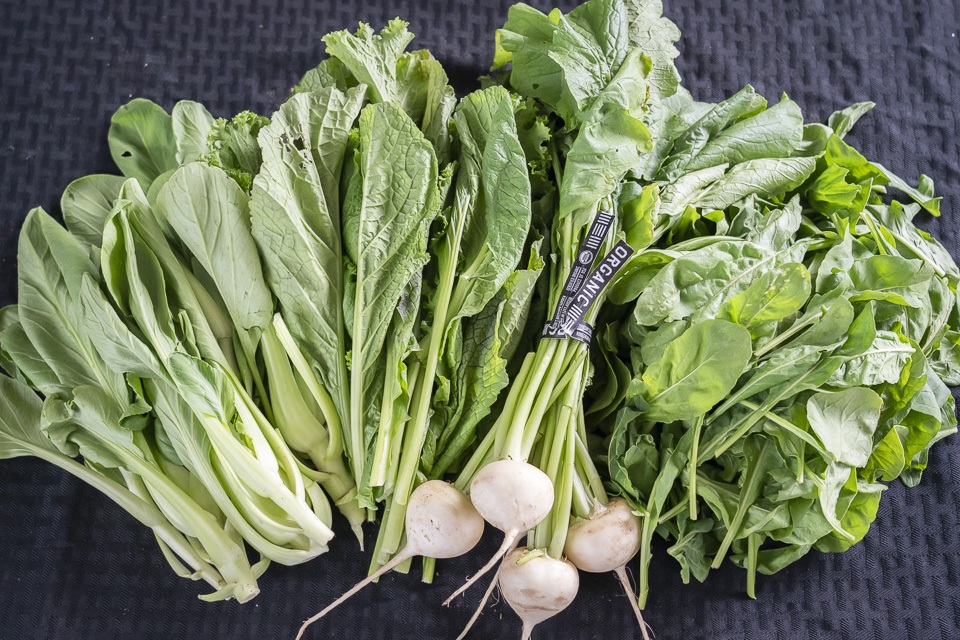 Baby bok choy, mustard, turnips, and arugula: just some of the cool-season crops that are trickling into CSA boxes and market stands, alike. Photo by Scott David Gordon
Baby bok choy, mustard, turnips, and arugula: just some of the cool-season crops that are trickling into CSA boxes and market stands, alike. Photo by Scott David Gordon
TWO: BELIEVE US: WE’RE DOING EVERYTHING WE CAN TO BRING YOU VARIETY
If you’re a locavore or home gardener who truly has a pulse on what is possible in the summer months, you may have noticed some surprisingly green guests in your CSA box these past few weeks. Arugula, bok choy, and mustard greens have made their late August, early-September debut in CSA boxes and market stands, alike. The journey of these leafy greens, however, was anything but simple. We are constantly testing the limits of planting windows, always with the goal to maybe, just maybe, bring you tomatoes in May or arugula in early September. Often, we don’t count on these plantings and view their potential success as somewhat experimental.
A week or so ago, it was a miraculous sight to see beds blanketed in bright green arugula, bok choy, and mustards. But it shouldn’t have been too much of a surprise - when we planted these greens, there was a concerted effort on the farm to keep a close eye on these crops, adjust watering schedules if needed, and keep the weeds at bay. This effort paid off, and we had succeeded in growing a successful crop on the fridge of a season! But, that was just part one in getting these crops into your kitchen. Tracy tells me the story of the bok choy: “We all agreed that if we were going to plant these things early, we’d have to adjust our harvest schedule a bit to accommodate for these more delicate crops being ready in the middle of the summer. They can’t be harvested and spend any time in the sun… I mean, it’s over 100 degrees almost every day, and it’s in the 90s by 8 or 9 in the morning. When are we going to harvest them? It can’t spend any time in the field (after it’s picked) or it will be toast. So we had to switch the schedule up - rather than harvesting squash first in the morning, we’d harvest the greens first thing while it’s still cool outside.” Harvesting bok choy early in the morning (at sunrise!) before harvesting squash may sound like a simple adjustment, but this one change can have ripple effects for our operation. For example, if squash was listed on the Whole Foods or Central Market distribution list for the day, the packing crew who meticulously puts these labor-intensive orders together would be behind schedule, waiting on squash.
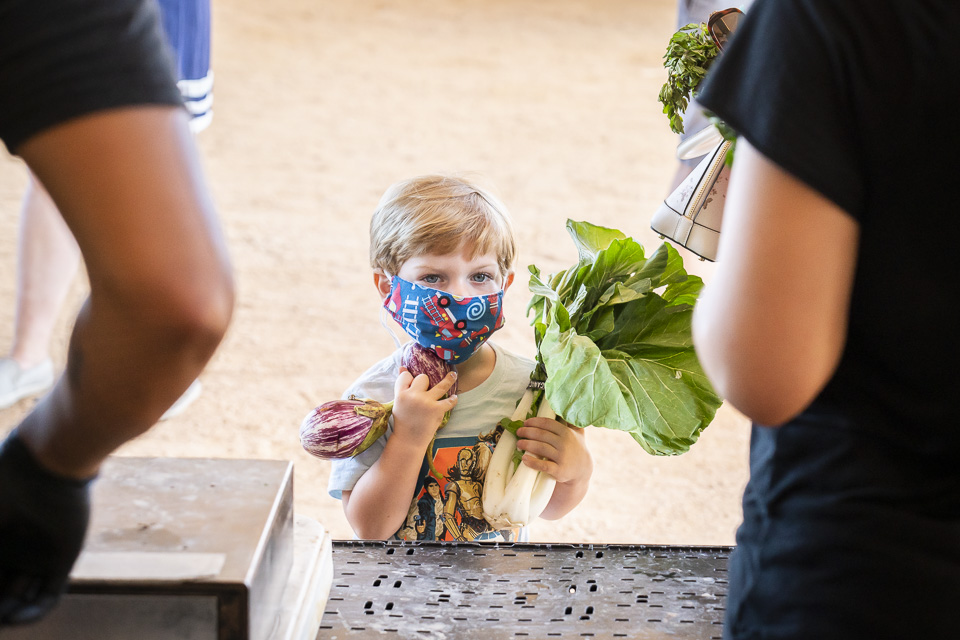 We know we've been talking about baby bok choy, but there are obviously some big boys, too. Photo by Scott David Gordon.
We know we've been talking about baby bok choy, but there are obviously some big boys, too. Photo by Scott David Gordon.
There are more adjustments that have to happen in the fields to make this bok choy, for example, happen, “To harvest this stuff and be happy with the quality, we had to make sure we had tractors and trailers out in the fields waiting for the harvest to be complete so that the second it was done, it was being trucked to the coolers.” Other summer crops like squash and melons can withstand a little bit of time in the sun, and our harvest crew can simply stack full bins near the end of the rows, and a tractor can scoop them up when it’s available. But for a leafy green like bok choy, it truly must be put in the cooler moments after it’s cut from the ground, else customers would be receiving pre-cooked baby bok choy, and we’re not really a meal-delivery company.
Once bok choy arrives at our packing shed, these tiny stalks are immediately dunked in cold water to remove the field heat. After a cool dunk, the bok choy is stored in the cooler, where we now pack our CSA shares, and remains in this cooler until it's transported to your doorstep or neighborhood. Tracy concludes the bok choy backstory by reiterating the whole-farm effort necessary to get an edge on seasonality, “From beginning to end, we gotta have that circle of communication from the farm to the barn to make it happen.”
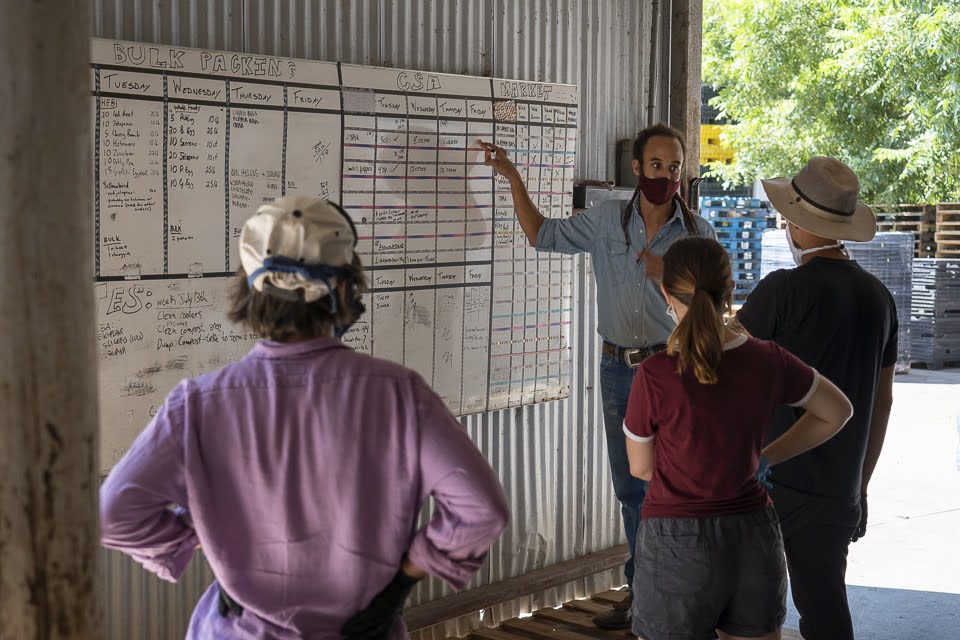 Farmer Tracy going over some of the numbers for the day. Photo by Scott David Gordon.
Farmer Tracy going over some of the numbers for the day. Photo by Scott David Gordon.
WE PROMISE WE HAVE OUR REASONS
When chatting with Tracy about the beautiful bok choy, it was clear that making this particular harvest happen was a labor of love. An early-season gift from the JBG Farmers to our CSA Members, and a gift that we’re proud of and excited to produce! But remember how we mentioned that plantings like this are somewhat experimental? When planning out our CSA Box Contents for August and September, the sudden availability of baby bok choy, for example, wasn’t accounted for.
 CSA Shares ready for pickup at the Mueller Farmers Market last weekend. Photo by Scott David Gordon.
CSA Shares ready for pickup at the Mueller Farmers Market last weekend. Photo by Scott David Gordon.
Tracy reflects on the decision to include the bok choy, anyway: “Something Brenton said to me years ago was on my mind this week. He was kind of talking about his core beliefs and ideas about the CSA and said, ‘Tracy, if this is ready and this is ready… let’s harvest it!’ And I’m like, ‘Brenton, I know it’s ready, but what are we going to do with it if you harvest it? We’ve already planned out the CSA contents, and we’re several days into finalizing the logistics. We’d have to change the harvest schedule, update the website, and possibly deal with upset customers who are trying to meal plan.’ And Brenton responded, ‘I understand all of this and those are all important… but these crops are amazing! They’re the best we have to offer right now, and I really want the best of what we have to go into the CSA boxes regardless of when it becomes ready. I don’t want our CSA members to miss out.’”
Planning the box contents for so many families, the building blocks of their weekly meals, is something we take very seriously. We promise that if you ever receive something in your share that you weren’t expecting, it’s there for a reason and it’s something we thought long and hard about; we’re not switching veggies on a whim and are always trying to find a balance between delivering exactly what we said we would, and also making sure you don’t miss out on the firsts of the season. Plants don’t always grow like we think they will, and our farm systems (and CSA box contents) sometimes have to adjust accordingly.
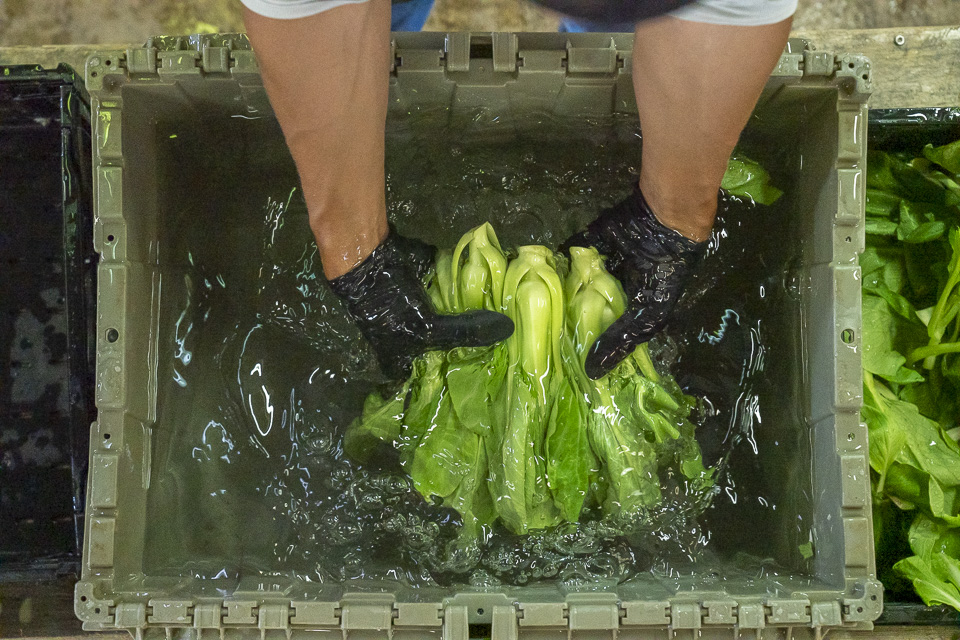 Dunked baby bok choy. Photo by Scott David Gordon.
Dunked baby bok choy. Photo by Scott David Gordon.
IN CONCLUSION
For years, we’ve grown, harvested, and packed for a pretty consistent number of CSA boxes. About 6 months ago, the number of CSA boxes we were packing on a daily basis doubled. Now, with a bit of distance from the 2020 March to remember, we’ve finally adjusted to this new volume, both from the planting and packing perspective. For those of you that may be new to the CSA, we want to thank you for supporting our local and organic farm! We know that making the shift to a more seasonally-focused diet can sometimes feel limiting compared to the endless isles of imported produce at the grocery store. You may wonder why one week you got huge honkers of sweet potatoes, and the next week you got a bundle of baby sweet potats. And the simple answer is beautiful - because they’re coming straight from the farm! Grocery stores have very strict size (and cosmetic) standards for the produce they’re willing to buy from farmers, but there are plenty of harvested crops that don’t qualify for that beauty pageant. As a member of our CSA Program, you are committing to supporting our whole farm and its whole harvest. You’ll start to notice how even the size of certain crops, like peppers, can change along with the season. Usually, at the beginning of the season when the plants are at their healthiest, peppers come in very large. The same pepper plant that produced ribbon-winning peppers at the beginning of the season will usually produce smaller peppers further into the summer. But Farmer Tracy wants to make sure you know that we’re always going to maintain the value of your CSA share and adjust for the changes in crop size. Smaller peppers in the field simply mean you get more peppers - equal to the volume of the early-season giants.
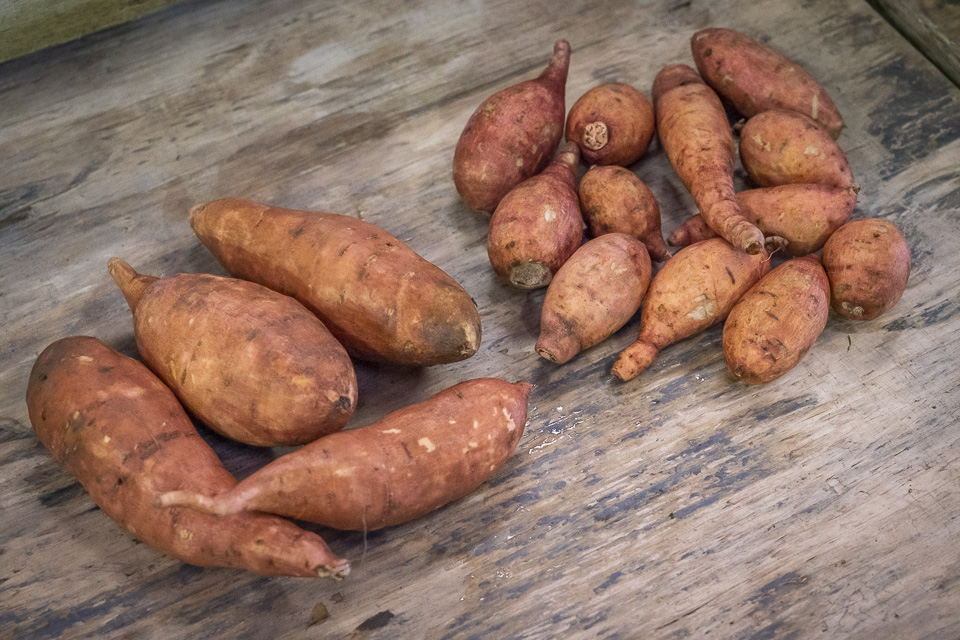 Same potato crop, different sizing possibilities... all delicious and nutritious! Photo by Scott David Gordon
Same potato crop, different sizing possibilities... all delicious and nutritious! Photo by Scott David Gordon
Farmer Tracy is setting the tone for this seasonal shift, and we’re eager to follow along, “Fall is so close. It’s going to be one of the best. There’s no such thing as luck. It’s preparation meets opportunity. We’re so prepared, top down!” If you’ve made it to the bottom of this post, we just want to say thank you for following along. And also! If you’re a CSA Member, we’ve got a little secret to tell you: Customization is OPEN! We’re not quite ready to shout it from the rooftops, yet, but if you happen to be reading this discreet announcement we want you to log in to your account and customize to your heart’s desire. This somewhat secret and slow return of our customization feature will help our CSA crew adjust to this big change and work out any kinks. Thanks for your support along the way!
As always, thanks for reading. Have a happy Labor Day!
Love, Your Farmers
 Farmer Tracy and his two kids, Obi and Eden, at our Garfield Farm back in March of 2019. Photo by Scott David Gordon.
Farmer Tracy and his two kids, Obi and Eden, at our Garfield Farm back in March of 2019. Photo by Scott David Gordon.
CSA BOX CONTENTS WEEK OF AUG 31ST
08/31/20 — Scott
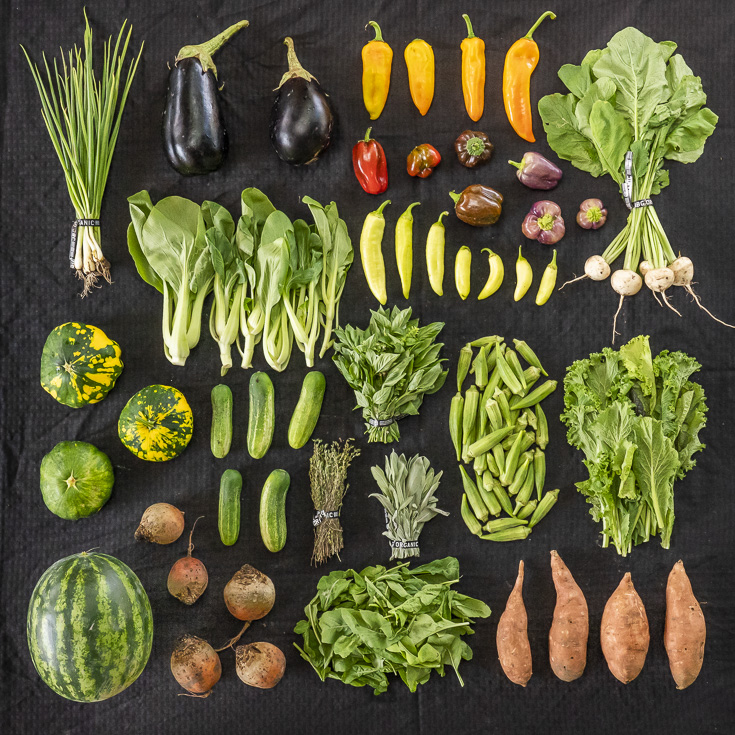 CSA Box Contents Week of Aug 31st
CSA Box Contents Week of Aug 31st
Large Box
Bok Choy
Eggplant
Greens, Farmers Choice
Greens, Mizuna
Herb
Melon
Okra
Onion, Multiplying
Pepper, Sweet
Summer Squash
Turnip, White Japanese
Bok Choy
Eggplant
Greens, Farmers Choice
Greens, Mizuna
Herb
Melon
Okra
Onion, Multiplying
Pepper, Sweet
Summer Squash
Turnip, White Japanese
Medium Box
Bok Choy
Eggplant
Greens, Farmers Choice
Herb
Melon
Pepper, Sweet
Potato, Sweet
Radish
Summer Squash
Turnip, White Japanese
Bok Choy
Eggplant
Greens, Farmers Choice
Herb
Melon
Pepper, Sweet
Potato, Sweet
Radish
Summer Squash
Turnip, White Japanese
Small Box
Bok Choy
Greens, Farmers Choice
Herb
Melon
Pepper, Sweet
Radish
Summer Squash
Bok Choy
Greens, Farmers Choice
Herb
Melon
Pepper, Sweet
Radish
Summer Squash
Individual Box
Bok Choy
Eggplant
Greens, Farmers Choice
Summer Squash
Turnip, White Japanese
Bok Choy
Eggplant
Greens, Farmers Choice
Summer Squash
Turnip, White Japanese
FIELD UPDATE WITH FARMER BRENTON: THE GREAT PIGWEED BATTLE
08/28/20 — Ada Broussard
Hello JBG newsletter readers! Ada here. I’ve worked at JBG for around 7 years in a variety of roles, most recently working on our newsletter. I hope you enjoy reading the farm blog each week! It’s one of the things that first attracted me to JBG so many years ago. It’s been a long while since I’ve set my boots on the soil at our Garfield, Texas farm, and this past week I made the trek east to catch-up and mask-up with Farmer Brenton.
These days, Brenton spends the mornings (and often the afternoons) on the tractor. The farm is busy preparing and planting for the fall season, and it’s an all-hands on deck sorta situation. Driving a tractor, especially some of or more antique models, is a very skilled job, and so having Brenton aboard helps ensure we stay on our planting schedule. I planned to meet Brenton at lunchtime (an understood 12 sharp), and when I arrived I found him under our butterfly pavilion in a metal folding chair, talking to Jack (our planting manager) who was in a coordinating metal chair about 10 feet away, clipboard, radio, and cell phone in hand.
![]() Brenton coordinating with Angel and Luke. Photo by Scott David Gordon.
Brenton coordinating with Angel and Luke. Photo by Scott David Gordon.
I have missed the incessant buzz of the farm and was so content to sit in my own metal chair, and for about 5 minutes, simply observe the whirling conversations, tasks, radio calls, and questions Brenton and Jack were fielding. This farmy hum of energy is palpable most days at JBG and it doesn’t really have an off season. Brenton was apologetic that he wasn’t quite ready to meet with me, but I knew that the buzz of his cell phone and exchanges with managers all needed to be addressed - they fuel the momentum that would keep the day, and week, and entire planting season rolling. At the time, Brenton and Jack were discussing the missing top link that was needed to get the tine weeder hooked up to tractor number 5. I learned that the top link was the upper portion of the three point hitch used to attach an implement and help it move backwards and forwards. With so many implements and tools at the farm, and so many different people using this equipment, we have some pretty established systems on what goes where. Despite all this, a top link can still go missing. (Spoiler: Temo knew where the link was.)
After chatting with Brenton and Jack for a while and meeting a few new faces, it was clear that lunch hour was ending. And so after masking up, I jumped in the backseat of Brenton’s truck so he could show me what was on his mind: several weeds and the thoughtfully orchestrated plan in place to get them under control. It’s been months since I’ve ridden in Brenton’s truck, but I was glad to see that not much has changed. Irrigation hoses and couplers, wrenches, mason jars stained with coffee, and who knows what else were pushed over so I could squeeze in the back seat.
![]() A farmer, his truck, and his coffee. Photo by Scott David Gordon.
A farmer, his truck, and his coffee. Photo by Scott David Gordon.
For the past year or two, a few types of weeds from the amaranth genus, including pigweed, have taken up shop in the JBG fields. These weeds can be voracious, and to be honest, we’ve let them get a little too comfortable. Over the past couple of years, there have been several moments in the season where we simply did not have the labor nor time to weed-out these plants like we would have wanted, and left untended, these crops grew, thrived, and dropped their seed... only compounding the problem and pressure.
![]() Pigweed at the farm. Photo by Scott David Gordon.
Pigweed at the farm. Photo by Scott David Gordon.
On a farm our size, weeds are particularly pesky: they can inhibit the growth of crops by competing for water, space, and nutrients. They can reduce the yield and quality of our crops and dramatically increase labor costs simply by existing - their presence among valuable row crops usually slows down the harvesting and sorting processes. To boot, big swaths of weeds on the farm can serve as a wonderful wintering ground for disease and harmful pests who would love nothing more than to hunkerdown amid the pigweed. In the business of growing vegetables on 184 acres, weeds like this are worrisome.
Heading into this fall season, Brenton and the Garfield crew knew we had to get the pigweed under control. As Temo put it - “We don’t really have a choice.” And so, Brenton and I drove his navy Nissan across the creek to the far side of the farm where he could show me how we were tackling the weeds using the tried and true technique known as stale seed bedding.
A stale seed bed is simply a method of weed control in which the bed and the soil are prepped weeks before the crop’s seed is planted. This prepped bed is watered, either by rain, sprinklers, or drip irrigation, allowing all of the weed seeds that are stealthy hiding in the top 2-3 inches of the seed bank to germinate and show themselves. After the weeds poke their heads out, they’re eliminated either by flame weeding or mechanical cultivation with our tine weeder- essentially a huge rake. This entire process can take about 3-5 weeks, but the end result is a prepped bed that is relatively weed-free, ready to absorb our direct-seeded fall crops…. Or our “cool-season direct” crops, for short. This includes vegetables like beets, carrots, turnips, chard, spinach, and radishes… aka everything you’d ever need for a massive harvest salad.
![]() Don't mock us for the weeds, okay? Photo by Scott David Gordon.
Don't mock us for the weeds, okay? Photo by Scott David Gordon.
Though we’ve occasionally used this method of weed control on the farm before, we’ve never done it on such a scale. Stale seed bedding acres upon acres of our farm means hours and hours (and hours) on the tractor, passing over one bed many additional times to list, shape, and cultivate the row all before the actual crop is ever planted. Stale seed bedding necessitates an impressive degree of foresight. In order to make sure our direct seeded crops get in the ground at the earliest possible moment (and keep the CSA box interesting!), we have to germinate the weed seeds about 4 weeks before that, and turn over the previous row or cover crop about a week before that, and schedule labor and order drip tape and prepare tools weeks before that, and so on and so forth.. Multiply that thought-processes by the whole farm, across all seasons, but most notably right now. In certain areas where the weeds are particularly rampant, we may even do the entire stale seed bed process twice. I’ve worked at JBG for many years, and I’m particularly proud of the farm this season. I can honestly say that we’ve reached a moment in our operational history in which we’re farming more and more proactively and less and less reactively. Way to go, team!
As we drove around the farm, Brenton showed me beds in various stages of the stale seedbed process. One bed was covered in a thin green blanket of freshly germinated sprouts… weeds, soon to be bid adieu. Another area had uniformly sculpted rows of rich looking soil, with only a few large weeds scattered about, blowing in the wind like easy targets. These beds had already been stale seed bedded, and the lingering couple of weeds were simply missed, but they were so few and far between that they could be easily removed by hand. These beds were practically weed-free, and were ready to be sown with orange carrots late successions of squash. I saw John and Ned laying drip tape in yet another set of beds that had just been turned over and shaped, ready to welcome the weeds weeks before beds of rainbow chard are sown.
![]() Okra flowers, pointing towards the sun. Photo by Scott David Gordon.
Okra flowers, pointing towards the sun. Photo by Scott David Gordon.
After thoroughly assessing all the beds in progress, Brenton and I drove around to look at some of the crops currently thriving in the ground. There were several rows of pristine baby bok choy, making their seasonal debut notably early. The okra plants are now over 5 feet tall, each topped with pale yellow flowers, pointed at the sun and standing high against the wide blue sky. We also saw rows of red radishes, and white Japanese turnips almost ready for snacking. A few beds over, Vicente and his team were harvesting watermelons. By this point of our visit, I could tell Brenton was itching to get back on the tractor, and so I took the cue and joined Vicente and his team for a while because I missed Vicente and I love watermelon. Later, I followed my nose to the wafting smell of basil and found Temo, who was disguised in a large hat, mask, and sunglasses, busy with the ambrosial tasks of removing basil plants which had gotten tangled in the metal blades of one of our cultivators. Later after that, I had a watermelon and basil salad, and thought of all the weed-free beds that will soon be brimming with cool season crops. Thanks Brenton, Jack, Adam, Giana, Temo, and Vicente for the visit. Till next time!
![]() Personal watermelon, brought to you by weed-free beds. Harvested by Israel, photographed by Scott.
Personal watermelon, brought to you by weed-free beds. Harvested by Israel, photographed by Scott.
These days, Brenton spends the mornings (and often the afternoons) on the tractor. The farm is busy preparing and planting for the fall season, and it’s an all-hands on deck sorta situation. Driving a tractor, especially some of or more antique models, is a very skilled job, and so having Brenton aboard helps ensure we stay on our planting schedule. I planned to meet Brenton at lunchtime (an understood 12 sharp), and when I arrived I found him under our butterfly pavilion in a metal folding chair, talking to Jack (our planting manager) who was in a coordinating metal chair about 10 feet away, clipboard, radio, and cell phone in hand.
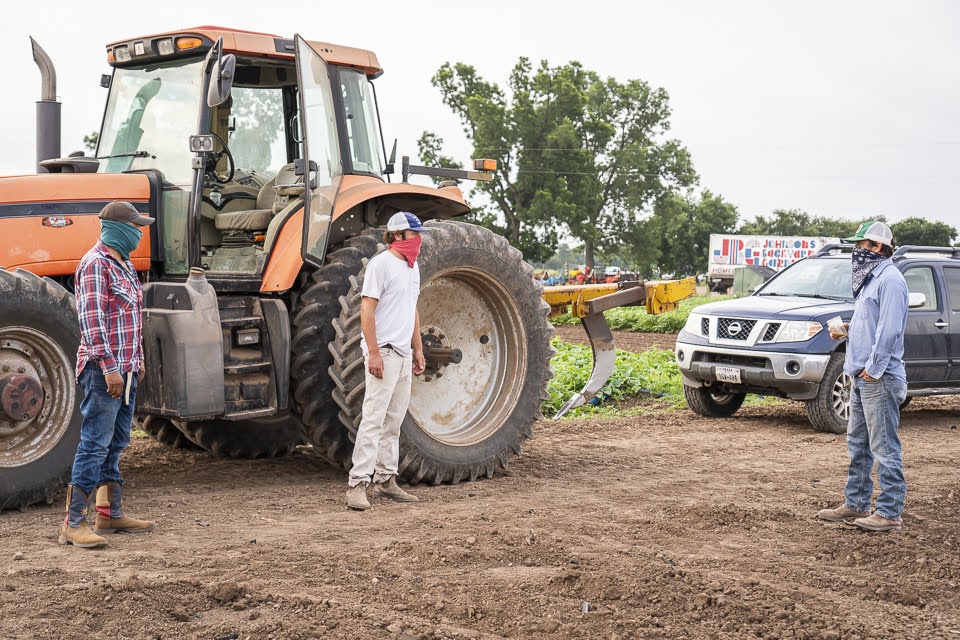 Brenton coordinating with Angel and Luke. Photo by Scott David Gordon.
Brenton coordinating with Angel and Luke. Photo by Scott David Gordon.
I have missed the incessant buzz of the farm and was so content to sit in my own metal chair, and for about 5 minutes, simply observe the whirling conversations, tasks, radio calls, and questions Brenton and Jack were fielding. This farmy hum of energy is palpable most days at JBG and it doesn’t really have an off season. Brenton was apologetic that he wasn’t quite ready to meet with me, but I knew that the buzz of his cell phone and exchanges with managers all needed to be addressed - they fuel the momentum that would keep the day, and week, and entire planting season rolling. At the time, Brenton and Jack were discussing the missing top link that was needed to get the tine weeder hooked up to tractor number 5. I learned that the top link was the upper portion of the three point hitch used to attach an implement and help it move backwards and forwards. With so many implements and tools at the farm, and so many different people using this equipment, we have some pretty established systems on what goes where. Despite all this, a top link can still go missing. (Spoiler: Temo knew where the link was.)
After chatting with Brenton and Jack for a while and meeting a few new faces, it was clear that lunch hour was ending. And so after masking up, I jumped in the backseat of Brenton’s truck so he could show me what was on his mind: several weeds and the thoughtfully orchestrated plan in place to get them under control. It’s been months since I’ve ridden in Brenton’s truck, but I was glad to see that not much has changed. Irrigation hoses and couplers, wrenches, mason jars stained with coffee, and who knows what else were pushed over so I could squeeze in the back seat.
 A farmer, his truck, and his coffee. Photo by Scott David Gordon.
A farmer, his truck, and his coffee. Photo by Scott David Gordon.
For the past year or two, a few types of weeds from the amaranth genus, including pigweed, have taken up shop in the JBG fields. These weeds can be voracious, and to be honest, we’ve let them get a little too comfortable. Over the past couple of years, there have been several moments in the season where we simply did not have the labor nor time to weed-out these plants like we would have wanted, and left untended, these crops grew, thrived, and dropped their seed... only compounding the problem and pressure.
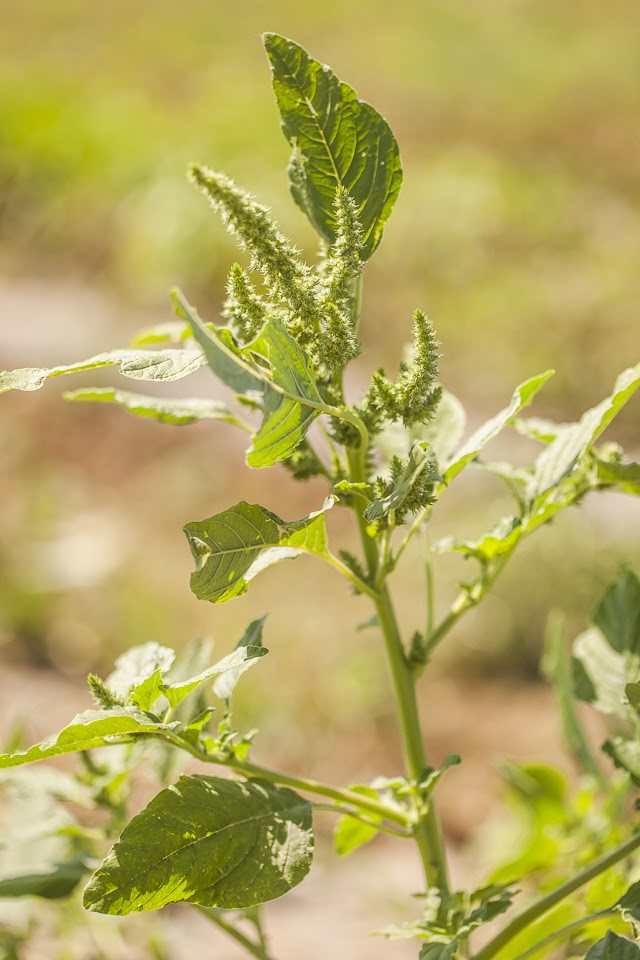 Pigweed at the farm. Photo by Scott David Gordon.
Pigweed at the farm. Photo by Scott David Gordon.
On a farm our size, weeds are particularly pesky: they can inhibit the growth of crops by competing for water, space, and nutrients. They can reduce the yield and quality of our crops and dramatically increase labor costs simply by existing - their presence among valuable row crops usually slows down the harvesting and sorting processes. To boot, big swaths of weeds on the farm can serve as a wonderful wintering ground for disease and harmful pests who would love nothing more than to hunkerdown amid the pigweed. In the business of growing vegetables on 184 acres, weeds like this are worrisome.
Heading into this fall season, Brenton and the Garfield crew knew we had to get the pigweed under control. As Temo put it - “We don’t really have a choice.” And so, Brenton and I drove his navy Nissan across the creek to the far side of the farm where he could show me how we were tackling the weeds using the tried and true technique known as stale seed bedding.
A stale seed bed is simply a method of weed control in which the bed and the soil are prepped weeks before the crop’s seed is planted. This prepped bed is watered, either by rain, sprinklers, or drip irrigation, allowing all of the weed seeds that are stealthy hiding in the top 2-3 inches of the seed bank to germinate and show themselves. After the weeds poke their heads out, they’re eliminated either by flame weeding or mechanical cultivation with our tine weeder- essentially a huge rake. This entire process can take about 3-5 weeks, but the end result is a prepped bed that is relatively weed-free, ready to absorb our direct-seeded fall crops…. Or our “cool-season direct” crops, for short. This includes vegetables like beets, carrots, turnips, chard, spinach, and radishes… aka everything you’d ever need for a massive harvest salad.
 Don't mock us for the weeds, okay? Photo by Scott David Gordon.
Don't mock us for the weeds, okay? Photo by Scott David Gordon.
Though we’ve occasionally used this method of weed control on the farm before, we’ve never done it on such a scale. Stale seed bedding acres upon acres of our farm means hours and hours (and hours) on the tractor, passing over one bed many additional times to list, shape, and cultivate the row all before the actual crop is ever planted. Stale seed bedding necessitates an impressive degree of foresight. In order to make sure our direct seeded crops get in the ground at the earliest possible moment (and keep the CSA box interesting!), we have to germinate the weed seeds about 4 weeks before that, and turn over the previous row or cover crop about a week before that, and schedule labor and order drip tape and prepare tools weeks before that, and so on and so forth.. Multiply that thought-processes by the whole farm, across all seasons, but most notably right now. In certain areas where the weeds are particularly rampant, we may even do the entire stale seed bed process twice. I’ve worked at JBG for many years, and I’m particularly proud of the farm this season. I can honestly say that we’ve reached a moment in our operational history in which we’re farming more and more proactively and less and less reactively. Way to go, team!
As we drove around the farm, Brenton showed me beds in various stages of the stale seedbed process. One bed was covered in a thin green blanket of freshly germinated sprouts… weeds, soon to be bid adieu. Another area had uniformly sculpted rows of rich looking soil, with only a few large weeds scattered about, blowing in the wind like easy targets. These beds had already been stale seed bedded, and the lingering couple of weeds were simply missed, but they were so few and far between that they could be easily removed by hand. These beds were practically weed-free, and were ready to be sown with orange carrots late successions of squash. I saw John and Ned laying drip tape in yet another set of beds that had just been turned over and shaped, ready to welcome the weeds weeks before beds of rainbow chard are sown.
 Okra flowers, pointing towards the sun. Photo by Scott David Gordon.
Okra flowers, pointing towards the sun. Photo by Scott David Gordon.
After thoroughly assessing all the beds in progress, Brenton and I drove around to look at some of the crops currently thriving in the ground. There were several rows of pristine baby bok choy, making their seasonal debut notably early. The okra plants are now over 5 feet tall, each topped with pale yellow flowers, pointed at the sun and standing high against the wide blue sky. We also saw rows of red radishes, and white Japanese turnips almost ready for snacking. A few beds over, Vicente and his team were harvesting watermelons. By this point of our visit, I could tell Brenton was itching to get back on the tractor, and so I took the cue and joined Vicente and his team for a while because I missed Vicente and I love watermelon. Later, I followed my nose to the wafting smell of basil and found Temo, who was disguised in a large hat, mask, and sunglasses, busy with the ambrosial tasks of removing basil plants which had gotten tangled in the metal blades of one of our cultivators. Later after that, I had a watermelon and basil salad, and thought of all the weed-free beds that will soon be brimming with cool season crops. Thanks Brenton, Jack, Adam, Giana, Temo, and Vicente for the visit. Till next time!
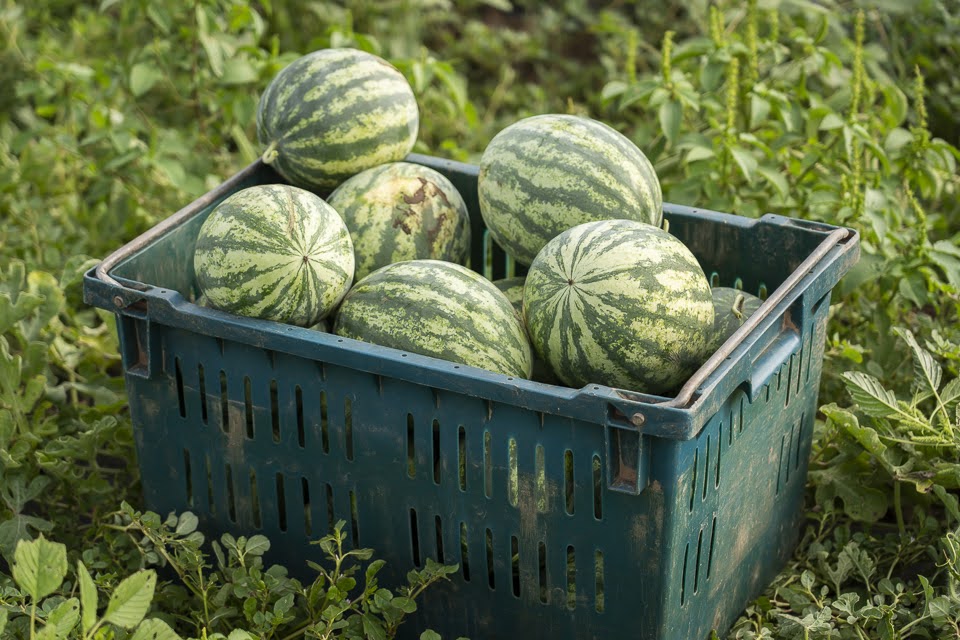 Personal watermelon, brought to you by weed-free beds. Harvested by Israel, photographed by Scott.
Personal watermelon, brought to you by weed-free beds. Harvested by Israel, photographed by Scott.
BEET PICKLED DEVILED EGGS
08/27/20 — Ada Broussard

Recipe and photo by Mackenzie Smith Kelley
Bring a 1:1 ratio of vinegar to water, and 4 tablespoons of honey to a boil, then add 3-4 peeled and sliced beets, a sliced onion, a teaspoon of whole peppercorns, a teaspoon of whole coriander and a dried chile pepper.
Cook until beets are soft. While the beet mixture is cooling, peel a dozen hard-boiled eggs. Pour beet mixture over peeled eggs, and let sit for as little as one hour (pictured here) to a few days. The longer the pickle, the more the color of the beets will permeate the eggs.
Enjoy as-is, or devil if you’re feeling fancy.
If deviling, slice eggs in half and remove yolks, smash with a fork, and add 1/2 cup labne or sour cream, a heaping tablespoon of roasted garlic achaar or sriracha and a pinch of salt. Taste, and salt as needed. Spoon yolk mixture back into egg whites and top with fresh chopped chives. The remaining pickled beets and onions will keep for about a week.
CSA BOX CONTENTS WEEK OF AUG 24TH
08/25/20 — Scott
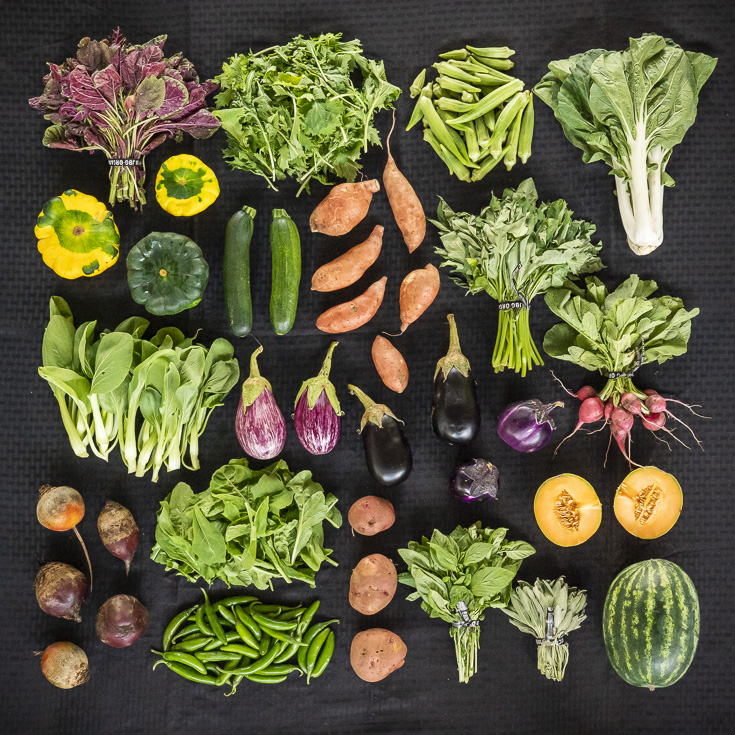 CSA Box Contents Week of Aug 24th
CSA Box Contents Week of Aug 24th
Large Box
Bok Choy, Baby
Eggplant
Greens, Arugula
Greens, Farmers Choice
Herb, Farmers Choice
Melon, Watermelon, Red
Okra
Pepper, Sweet Medley
Potato
Radish
Squash. Summer Medley
Bok Choy, Baby
Eggplant
Greens, Arugula
Greens, Farmers Choice
Herb, Farmers Choice
Melon, Watermelon, Red
Okra
Pepper, Sweet Medley
Potato
Radish
Squash. Summer Medley
Medium Box
Beets
Greens, Farmers Choice
Greens, Mustard
Herb, Farmers Choice
Melon, Watermelon, Red
Okra
Pepper, Sweet Medley
Potato
Radish
Squash. Summer Medley
Beets
Greens, Farmers Choice
Greens, Mustard
Herb, Farmers Choice
Melon, Watermelon, Red
Okra
Pepper, Sweet Medley
Potato
Radish
Squash. Summer Medley
Small Box
Beets
Bok Choy, Baby
Eggplant
Greens, Farmers Choice
Herb, Farmers Choice
Okra
Potato
Beets
Bok Choy, Baby
Eggplant
Greens, Farmers Choice
Herb, Farmers Choice
Okra
Potato
Individual Box
Greens, Arugula
Greens, Farmers Choice
Melon, Watermelon, Red
Okra
Radish
Greens, Arugula
Greens, Farmers Choice
Melon, Watermelon, Red
Okra
Radish
A FARMER'S GUIDE TO MEAL PREP: A WEEK OF (EASY) DINNERS
08/21/20 — Ada Broussard
For those of you who have kids, Fall might as well be the official start of the year. Under normal circumstances, that transition from late nights and all-day snackathons to early bedtimes and homework can be tough. This year? It’s only the beginning of school season and we’re already throwing our straw hats wildly into the air for the parents among you. We wish you grace and humor as you gear up for the 2020 school year. For some of you, that may mean you’re full-on homeschooling for the first time. For others, perhaps you’re navigating hybrid models and block scheduling filled with synchronous Zooms and online assignments. Maybe it means sending your kiddo to school in a mask, fingers crossed that they stay safe and are able to feel like a normal 3rd grader after the summer that never seemed to end. Wherever, exactly, you are… we see you. What to feed your family shouldn’t be a source of shame or worry for you, ever, but especially as you gear up for school. Your farmers are proud advocates of pizza nights, two nights in a row, if that’s what feels right after a long day.
If you’re reading this, chances are you value incorporating seasonal produce into your cooking. There is no doubt that cooking with fresh ingredients will yield wholesome and delicious food. We're here to remind you that this food can also be painfully simple. The start of school for folks with kids will undoubtedly invite a bit of chaos… don’t let the questions of what’s for dinner to illicit additional stress. At the most basic level, it just needs to be edible.
![]() Our friend Martha knew the age old trick of making leftovers new: put an egg on it!
Our friend Martha knew the age old trick of making leftovers new: put an egg on it!
On our busy weeks at the farm, we farmers turn to simple, hearty, and veggie-filled meals that involve lots of carryover to the next day, little brain power, and in this instance - lots of rice. We thought we’d share what a week of really easy cooking can look like.
We’re keeping it simple for Monday while also knocking out some meal prep for the rest of the week. On Monday, make one anchor protein and serve it with a side of roasted veggies and aioli dipping sauce. Your anchor can be burgers, as we suggested, but it can also maybe be a piece of fish, roasted chicken thighs, or something else that feels easy and filling. Here, you have a choice on the amount of time you want to invest in this meal: buy pre-made burger patties or an already cooked rotisserie chicken if you’re feeling like your time is best spent outside the kitchen, or go for broke and make it all from scratch. You can also dance somewhere in between: roast chicken thighs, but skip the part where you read a bunch of recipes and simply season them with salt, pepper, and olive oil and roast in a hot oven until done.
Veggies: Use whatever you have! Sweet potatoes, regular potatoes, beets, okra, eggplant and squash are all in season right now and are all very roast-able. Roast veggies of similar densities with similar cooking times on the same tray. Leave some space between each veggie on the tray so they brown vs. steam. Sweet potatoes, regular potatoes and beets, for example, could all be roasted together as long as you cut them in similar sized shapes. Eggplant and okra take about the same amount of time, and squash can be done in almost no time. Roasting veggies should happen in a 400-425 degree oven. The veggies are fresh, and so seasoning with just oil, salt, and pepper is a-okay.
MONDAY NOTES: You may already be used to cooking this way, but if not, we encourage you to really hear us: this week’s sample meal plan necessitates cooking more than you need for that night. Channel your inner church-lady and at least double (or more) the amount of some of your meal’s components. These leftovers should really be considered nextovers in your mind - prepped food that will seamlessly carry over to tomorrow night’s dinner (and beyond), jazzed up in a way that will make you forget Monday ever happened.
On Monday, we suggest you double or triple the amount of veggies you roast. If you’re roasting sweet potatoes, for example, roast all of the ones that came in your CSA box! A cubed, roasted potato in the fridge is a way easier ingredient to incorporate into a future meal than a raw potato on the counter. Plus, your oven is on anyway... so you may as well only heat up your kitchen once this week. If you've got a lot of veggies to roast, do them in batches making sure to not crowd your pan. Yes, this method may take a bit longer to cook all of your veggies, but the end result will yield way better nextovers.
If you’re making hamburgers, buy extra meat and before you cook burgers for the night, roll the extra meat into quick meatballs, cook, and let cool in a glass tupperware on the counter while you cook the actual burgers. Store the meatballs in the fridge for tomorrow. The same goes for any protein, if you’d like. Make extra chicken or a few additional filets of fish, and thank us later.
A NOTE ON THE AOILI: Okay, we know, we said simple, and making your own aioli might feel somewhat extra (but it’s really not that hard). If that’s the case, skip this part and simply zhuzh up some mayo with grated garlic, lemon, and maybe some chopped herbs. But whatever you do, don’t skip the dipping sauce all together. We think this sauce may just be the key to getting your kiddos excited about the idea of a roasted tray of veggies. And if dipping veggies in mayo feels weird, go ahead and just make the aioli and see if we can’t change your mind. (Homemade aioli is delicious and is the perfect partner to any roasted, steamed, or boiled veggie!) Feeling particularly patient? Involve your kiddo in the sauce-making itself. Vocab word: emulsion. If you’re making your own aioli, make double what you thin you need, and then some more, because home made aioli goes with everything.
![]() A little (or a lot) of upfront prep means very quick meals for the rest of the week.
A little (or a lot) of upfront prep means very quick meals for the rest of the week.
Entering Tuesday, you should have several tupperwares full of leftover roasted veggies in your fridge including things like sweet potatoes, beets, and maybe some okra. Tonight, you’re eating these veggies over rice and calling it a grain bowl, buddha bowl, or whatever. The only major cooking you’re doing tonight is making rice! Steam a big pot of rice, ideally about three times more than you think your family will eat on Tuesday, and ideally flavored with lots of butter. We like white Jasmine rice. Protip: If you're making a large quantity of rice, the usual 2.1 water to rice ratio should be slightly tweaked and the amount of water reduced. Here's an explanation on why.
You can take this simple idea of veggies over rice in many different directions. Direction one: just eat the re-heated veggies over the warm rice, topped with some of that leftover aioli. Perhaps you do about 20 seconds more of cooking and add siracha to your aioli, call it spicy mayo, and pretend like eating a poke bowl on the sands of Hawaii. Or, you can add a can of black beans and corn plus loads of lime juice and avocado (and tortilla chips?) for a more Mexican take on the bowl. A grain bowl like this is also a wonderful opportunity to incorporate any raw vegetables you received in your CSA box like sliced cucumber or tomato, sliced sweet peppers, and a handful of salad greens. If you’re out of aioli but feel like your rice bowl needs a sauce, follow your heart and don’t over think it. Maybe it’s as simple as another pad of butter, some dashes of soy, some chili crisp, or a miso vinaigrette. Got a jar of pesto? Dollop that on top. If you have leftover protein from Monday, add this to your rice bowls, too. If you want to make this rice bowl more exciting, batter and fry some okra or eggplant (if you didn’t roast it all), and top the bowl with that! Pickled things lining the doors of your fridge? Those would work well, also. We strongly support the addition of any fresh and finely chopped herb like cilantro, dill, parsley, or green onions.
![]() When in doubt, roast it up!
When in doubt, roast it up!
Leftover rice that’s been sitting in the fridge dries out a bit, making the perfect case to be fried. Tonight, you’re making a ginormous batch of fried rice and the only cooking you’re doing is chopping some veggies and making a quick sauce.
Begin your friend rice by gathering all of your ingredients and making a simple sauce with ingredients like soy, mirin, sesame oil and maybe some oyster or hoisin. We’re not necessarily shooting for authenticity here, but are instead imparting flavor to rice in a way that feels intuitive. Soy sauce will add salt, umami, and color to your fried rice, mirin (or lemon or lime juice) some acidity, and oyster or hoisin some sweetness. We so regularly cook a quick, veggie-filled fried rice that we buy green onions at the store every time we go. Chop these up, too.
Locate the biggest skillet you own. Fried rice comes together quickly, so before you turn on the heat, chop whatever seasonal veggies you’d like to use. Hopefully you have some onions on hand, and can add that, too. Just about anything goes; be mindful that if you’re using red beets, these are better cooked separately and added on top of each bowl because fuchsia rice isn’t that appetizing. Start cooking your fried rice by sautéing some onions and aromatics like ginger and garlic in a generous amount of high-heat oil. Next, add any other raw vegetables that came in your CSA haul - chopped peppers, squash, okra, bok choy, finely chopped sweet potato greens… they’d all work perfectly! Once your veggies are cooked but still have some bite (al dente), it’s time to turn up the heat, add your rice, sauce, and any other leftover roasted veggies and protein from Monday and Tuesday. Hopefully you bought the green onions; add these too. Cook until incorporated and warmed through, on higher heat than you may think. Taste, and don’t be afraid to adjust, adding more soy if it needs salt, or acid or sugar. Give everyone big bowls of piping hot fried rice (and chop sticks, if you’ve got ‘em) and if you do it right, it’s more than more than enough.
![]()
We know. You had fried rice last night. And maybe your family has expectations of having something different every night, but maybe everyone should just embrace the idea of glorified nextovers and minimal dishes to wash?
Thursday night’s fried rice can be stretched or made-new by additional veggies like frozen peas or grated carrots. Our favorite trick for fried-rice embellishment is the egg: fry an egg to top each bowl, or incorporate scrambled eggs into the rice itself during the reheating process. Bean sprouts, corn, and pineapple are great canned goods to keep in the pantry for fried rice 2.0, or maybe you rehydrate a bag of seaweed. Sprinkle toasted sesame seeds or roasted peanuts on 2.0, or go crazy and top with some crispy bacon or sauteed mushrooms or fried tofu or anything else that you will. Congrats, tonight you fed your family a nourishing bowl of fried rice that took almost no time.
*If having fried rice two nights in a row feels wrong to you, feel free to change the order of Thursday and Friday.
Our blog and recipe archive is full of creative, diverse, and exciting dishes to make. And yes, cooking new things and Instagram-worthy meals is very fun. But also? It’s just food, there to nourish your body and give you the calories you need to navigate asynchronous learning sessions and spotty internet connections. When in doubt, roast veggies, make rice, and order pizza. Cheers!
![]()
If you’re reading this, chances are you value incorporating seasonal produce into your cooking. There is no doubt that cooking with fresh ingredients will yield wholesome and delicious food. We're here to remind you that this food can also be painfully simple. The start of school for folks with kids will undoubtedly invite a bit of chaos… don’t let the questions of what’s for dinner to illicit additional stress. At the most basic level, it just needs to be edible.
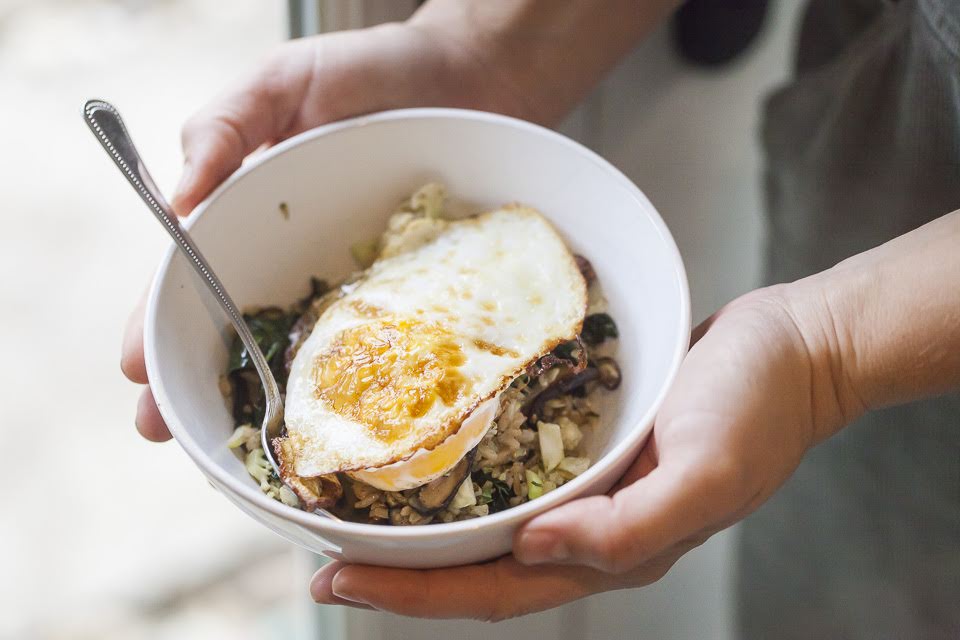 Our friend Martha knew the age old trick of making leftovers new: put an egg on it!
Our friend Martha knew the age old trick of making leftovers new: put an egg on it!
On our busy weeks at the farm, we farmers turn to simple, hearty, and veggie-filled meals that involve lots of carryover to the next day, little brain power, and in this instance - lots of rice. We thought we’d share what a week of really easy cooking can look like.
MONDAY: BURGERS + ROASTED VEGGIES AND AIOLI DIPPING SAUCE.
We’re keeping it simple for Monday while also knocking out some meal prep for the rest of the week. On Monday, make one anchor protein and serve it with a side of roasted veggies and aioli dipping sauce. Your anchor can be burgers, as we suggested, but it can also maybe be a piece of fish, roasted chicken thighs, or something else that feels easy and filling. Here, you have a choice on the amount of time you want to invest in this meal: buy pre-made burger patties or an already cooked rotisserie chicken if you’re feeling like your time is best spent outside the kitchen, or go for broke and make it all from scratch. You can also dance somewhere in between: roast chicken thighs, but skip the part where you read a bunch of recipes and simply season them with salt, pepper, and olive oil and roast in a hot oven until done.
Veggies: Use whatever you have! Sweet potatoes, regular potatoes, beets, okra, eggplant and squash are all in season right now and are all very roast-able. Roast veggies of similar densities with similar cooking times on the same tray. Leave some space between each veggie on the tray so they brown vs. steam. Sweet potatoes, regular potatoes and beets, for example, could all be roasted together as long as you cut them in similar sized shapes. Eggplant and okra take about the same amount of time, and squash can be done in almost no time. Roasting veggies should happen in a 400-425 degree oven. The veggies are fresh, and so seasoning with just oil, salt, and pepper is a-okay.
MONDAY NOTES: You may already be used to cooking this way, but if not, we encourage you to really hear us: this week’s sample meal plan necessitates cooking more than you need for that night. Channel your inner church-lady and at least double (or more) the amount of some of your meal’s components. These leftovers should really be considered nextovers in your mind - prepped food that will seamlessly carry over to tomorrow night’s dinner (and beyond), jazzed up in a way that will make you forget Monday ever happened.
On Monday, we suggest you double or triple the amount of veggies you roast. If you’re roasting sweet potatoes, for example, roast all of the ones that came in your CSA box! A cubed, roasted potato in the fridge is a way easier ingredient to incorporate into a future meal than a raw potato on the counter. Plus, your oven is on anyway... so you may as well only heat up your kitchen once this week. If you've got a lot of veggies to roast, do them in batches making sure to not crowd your pan. Yes, this method may take a bit longer to cook all of your veggies, but the end result will yield way better nextovers.
If you’re making hamburgers, buy extra meat and before you cook burgers for the night, roll the extra meat into quick meatballs, cook, and let cool in a glass tupperware on the counter while you cook the actual burgers. Store the meatballs in the fridge for tomorrow. The same goes for any protein, if you’d like. Make extra chicken or a few additional filets of fish, and thank us later.
A NOTE ON THE AOILI: Okay, we know, we said simple, and making your own aioli might feel somewhat extra (but it’s really not that hard). If that’s the case, skip this part and simply zhuzh up some mayo with grated garlic, lemon, and maybe some chopped herbs. But whatever you do, don’t skip the dipping sauce all together. We think this sauce may just be the key to getting your kiddos excited about the idea of a roasted tray of veggies. And if dipping veggies in mayo feels weird, go ahead and just make the aioli and see if we can’t change your mind. (Homemade aioli is delicious and is the perfect partner to any roasted, steamed, or boiled veggie!) Feeling particularly patient? Involve your kiddo in the sauce-making itself. Vocab word: emulsion. If you’re making your own aioli, make double what you thin you need, and then some more, because home made aioli goes with everything.
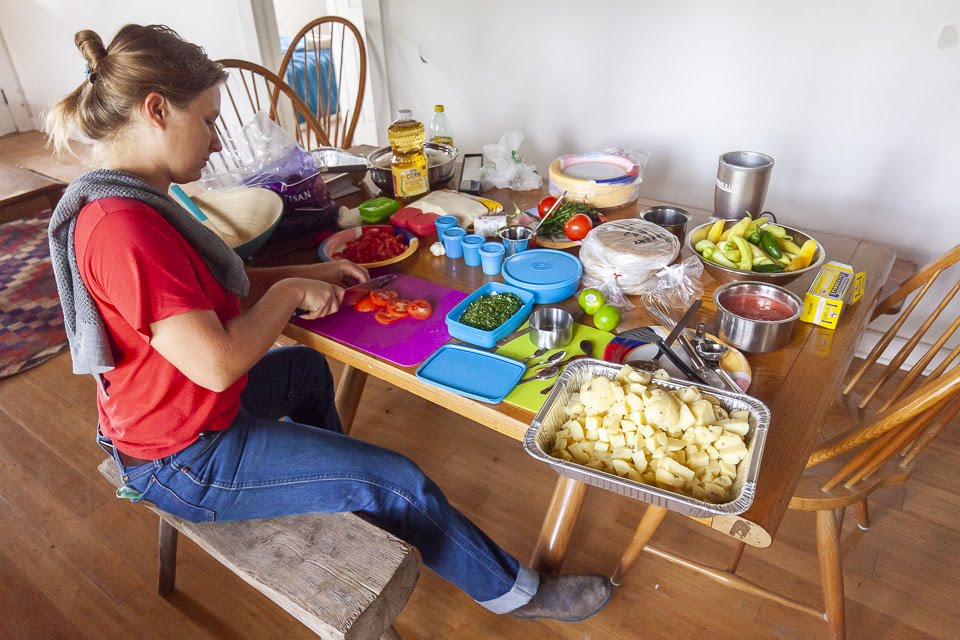 A little (or a lot) of upfront prep means very quick meals for the rest of the week.
A little (or a lot) of upfront prep means very quick meals for the rest of the week.
TUESDAY: GRAIN BOWLS
Entering Tuesday, you should have several tupperwares full of leftover roasted veggies in your fridge including things like sweet potatoes, beets, and maybe some okra. Tonight, you’re eating these veggies over rice and calling it a grain bowl, buddha bowl, or whatever. The only major cooking you’re doing tonight is making rice! Steam a big pot of rice, ideally about three times more than you think your family will eat on Tuesday, and ideally flavored with lots of butter. We like white Jasmine rice. Protip: If you're making a large quantity of rice, the usual 2.1 water to rice ratio should be slightly tweaked and the amount of water reduced. Here's an explanation on why.
You can take this simple idea of veggies over rice in many different directions. Direction one: just eat the re-heated veggies over the warm rice, topped with some of that leftover aioli. Perhaps you do about 20 seconds more of cooking and add siracha to your aioli, call it spicy mayo, and pretend like eating a poke bowl on the sands of Hawaii. Or, you can add a can of black beans and corn plus loads of lime juice and avocado (and tortilla chips?) for a more Mexican take on the bowl. A grain bowl like this is also a wonderful opportunity to incorporate any raw vegetables you received in your CSA box like sliced cucumber or tomato, sliced sweet peppers, and a handful of salad greens. If you’re out of aioli but feel like your rice bowl needs a sauce, follow your heart and don’t over think it. Maybe it’s as simple as another pad of butter, some dashes of soy, some chili crisp, or a miso vinaigrette. Got a jar of pesto? Dollop that on top. If you have leftover protein from Monday, add this to your rice bowls, too. If you want to make this rice bowl more exciting, batter and fry some okra or eggplant (if you didn’t roast it all), and top the bowl with that! Pickled things lining the doors of your fridge? Those would work well, also. We strongly support the addition of any fresh and finely chopped herb like cilantro, dill, parsley, or green onions.
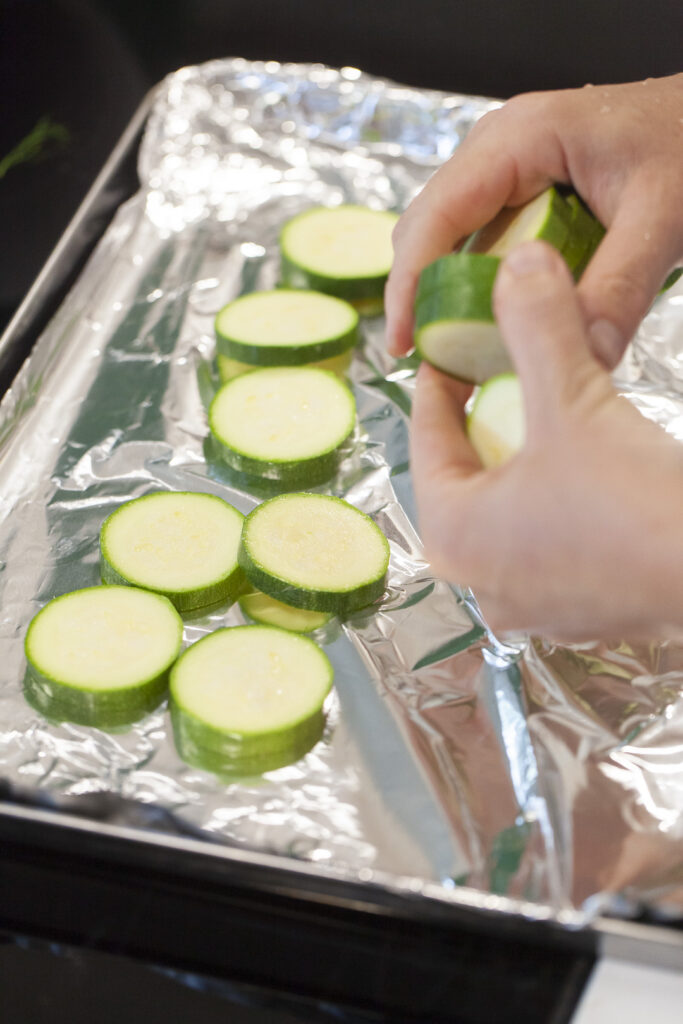 When in doubt, roast it up!
When in doubt, roast it up!
WEDNESDAY: FRIED RICE
Leftover rice that’s been sitting in the fridge dries out a bit, making the perfect case to be fried. Tonight, you’re making a ginormous batch of fried rice and the only cooking you’re doing is chopping some veggies and making a quick sauce.
Begin your friend rice by gathering all of your ingredients and making a simple sauce with ingredients like soy, mirin, sesame oil and maybe some oyster or hoisin. We’re not necessarily shooting for authenticity here, but are instead imparting flavor to rice in a way that feels intuitive. Soy sauce will add salt, umami, and color to your fried rice, mirin (or lemon or lime juice) some acidity, and oyster or hoisin some sweetness. We so regularly cook a quick, veggie-filled fried rice that we buy green onions at the store every time we go. Chop these up, too.
Locate the biggest skillet you own. Fried rice comes together quickly, so before you turn on the heat, chop whatever seasonal veggies you’d like to use. Hopefully you have some onions on hand, and can add that, too. Just about anything goes; be mindful that if you’re using red beets, these are better cooked separately and added on top of each bowl because fuchsia rice isn’t that appetizing. Start cooking your fried rice by sautéing some onions and aromatics like ginger and garlic in a generous amount of high-heat oil. Next, add any other raw vegetables that came in your CSA haul - chopped peppers, squash, okra, bok choy, finely chopped sweet potato greens… they’d all work perfectly! Once your veggies are cooked but still have some bite (al dente), it’s time to turn up the heat, add your rice, sauce, and any other leftover roasted veggies and protein from Monday and Tuesday. Hopefully you bought the green onions; add these too. Cook until incorporated and warmed through, on higher heat than you may think. Taste, and don’t be afraid to adjust, adding more soy if it needs salt, or acid or sugar. Give everyone big bowls of piping hot fried rice (and chop sticks, if you’ve got ‘em) and if you do it right, it’s more than more than enough.
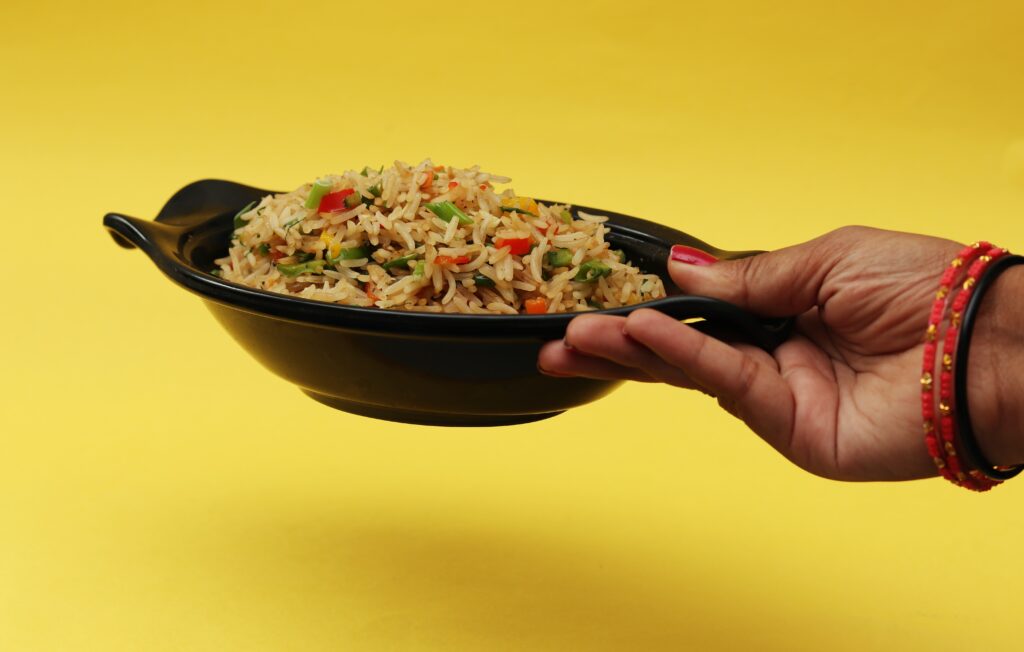
THURSDAY: FRIED RICE 2.0
We know. You had fried rice last night. And maybe your family has expectations of having something different every night, but maybe everyone should just embrace the idea of glorified nextovers and minimal dishes to wash?
Thursday night’s fried rice can be stretched or made-new by additional veggies like frozen peas or grated carrots. Our favorite trick for fried-rice embellishment is the egg: fry an egg to top each bowl, or incorporate scrambled eggs into the rice itself during the reheating process. Bean sprouts, corn, and pineapple are great canned goods to keep in the pantry for fried rice 2.0, or maybe you rehydrate a bag of seaweed. Sprinkle toasted sesame seeds or roasted peanuts on 2.0, or go crazy and top with some crispy bacon or sauteed mushrooms or fried tofu or anything else that you will. Congrats, tonight you fed your family a nourishing bowl of fried rice that took almost no time.
*FRIDAY: PIZZA
Order pizza and have it delivered to your home. If the adults among you feel like they need something more, toss that lingering arugula from your CSA box with olive oil, lemon juice and salt and top each pizza slice with a big handful of dressed arugula, shoving the greens and pizza into your both all in one. It’s like a salad, except without the dishes. Lingering cucumbers, carrots, or tomatoes? Chop ‘em up and serve with ranch dressing while you wait for the pizza to arrive. Dip pizza in leftover ranch, but did we really need to specify that bit?*If having fried rice two nights in a row feels wrong to you, feel free to change the order of Thursday and Friday.
Our blog and recipe archive is full of creative, diverse, and exciting dishes to make. And yes, cooking new things and Instagram-worthy meals is very fun. But also? It’s just food, there to nourish your body and give you the calories you need to navigate asynchronous learning sessions and spotty internet connections. When in doubt, roast veggies, make rice, and order pizza. Cheers!
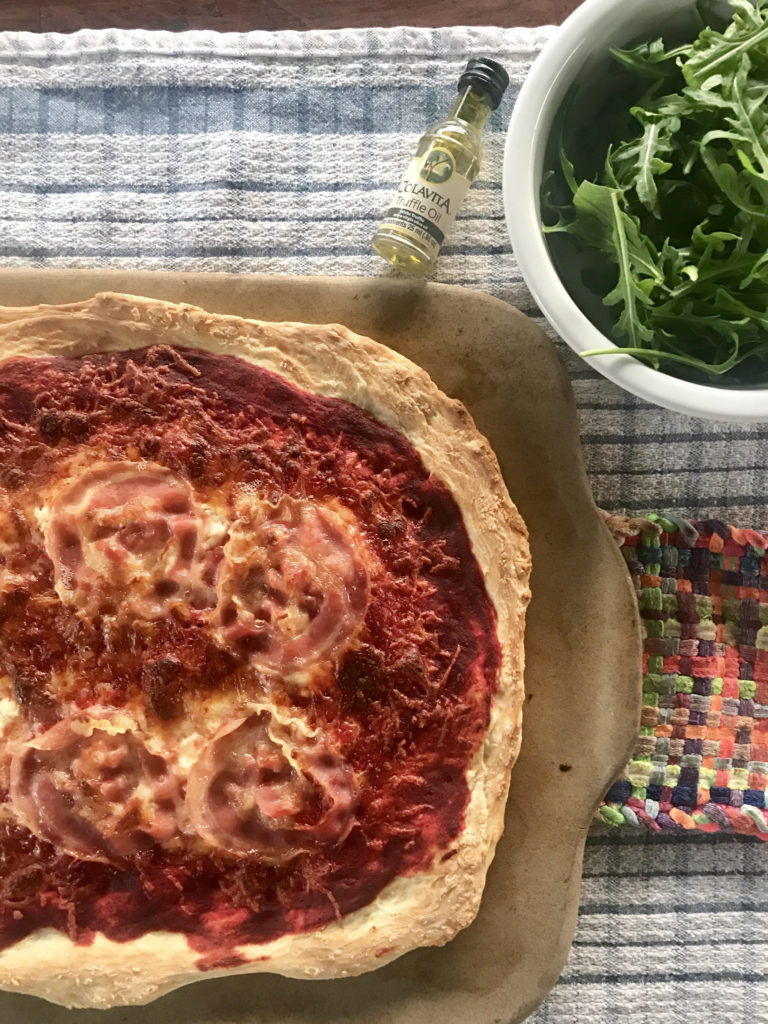
PHOTOS FROM THE FARM: 8.21.20
08/21/20 — Ada Broussard
We sometimes feel like a broken record when we say "It was a busy week at the farm", but this past week was extraordinarily busy, especially for our planting crew who are keeping an incredible planting pace, making sure to stay on schedule for a bountiful fall to come. It's so easy to get behind in planting, but so far this year, we're right on time.
![]() August is a very busy seeding month. Here, to crew members catch a ride on the transplanter to place one individual seed in the whole that was just punched by the wheel in front of them. Photo by Scott David Gordon.
August is a very busy seeding month. Here, to crew members catch a ride on the transplanter to place one individual seed in the whole that was just punched by the wheel in front of them. Photo by Scott David Gordon.
![]() A meeting of the minds: Ricky, Tracy, and Andrew gathered around a harvest of arugula, likely discussing the harvest available for CSA packing for the day, but maybe discussing the current book on their nightstand. Photo by Scott David Gordon.
A meeting of the minds: Ricky, Tracy, and Andrew gathered around a harvest of arugula, likely discussing the harvest available for CSA packing for the day, but maybe discussing the current book on their nightstand. Photo by Scott David Gordon.
![]() Healthy and vibrant squash plants, ready to transition us to fall Photo by Scott David Gordon.
Healthy and vibrant squash plants, ready to transition us to fall Photo by Scott David Gordon.
![]() Farmer Brenton cheesing on the Landini, one of the farm's high-crop tractors, with wheels so high it can drive over rows of crops without damaging them! Photo by Scott David Gordon.
Farmer Brenton cheesing on the Landini, one of the farm's high-crop tractors, with wheels so high it can drive over rows of crops without damaging them! Photo by Scott David Gordon.
![]() Is there any job where you're required to troubleshoot more often? Photo by Scott David Gordon.
Is there any job where you're required to troubleshoot more often? Photo by Scott David Gordon.
![]() Old vans and trucks, hand-painted with love for time on the highway and now spending their retirement in a more pastoral setting. Photo by Scott David Gordon.
Old vans and trucks, hand-painted with love for time on the highway and now spending their retirement in a more pastoral setting. Photo by Scott David Gordon.
![]() Photo by Scott David Gordon.
Photo by Scott David Gordon.
![]() A freshly sprayed loading dock is a beautiful thing. Photo by Scott David Gordon.
A freshly sprayed loading dock is a beautiful thing. Photo by Scott David Gordon.
![]() More. Watermelon. Augua fresca, anyone? Photo by Scott David Gordon.
More. Watermelon. Augua fresca, anyone? Photo by Scott David Gordon.
![]() The inside of our greenhouse is reaching capacity. Fall crops are coming! Photo by Scott David Gordon.
The inside of our greenhouse is reaching capacity. Fall crops are coming! Photo by Scott David Gordon.
![]() Outside, we have an area that we call "the shade structure". Here, shade cloth is stretched above these metal poles, providing a cooler environment for even more fall transplants. Photo by Scott David Gordon.
Outside, we have an area that we call "the shade structure". Here, shade cloth is stretched above these metal poles, providing a cooler environment for even more fall transplants. Photo by Scott David Gordon.
![]() If farm vehicles could talk... Photo by Scott David Gordon.
If farm vehicles could talk... Photo by Scott David Gordon.
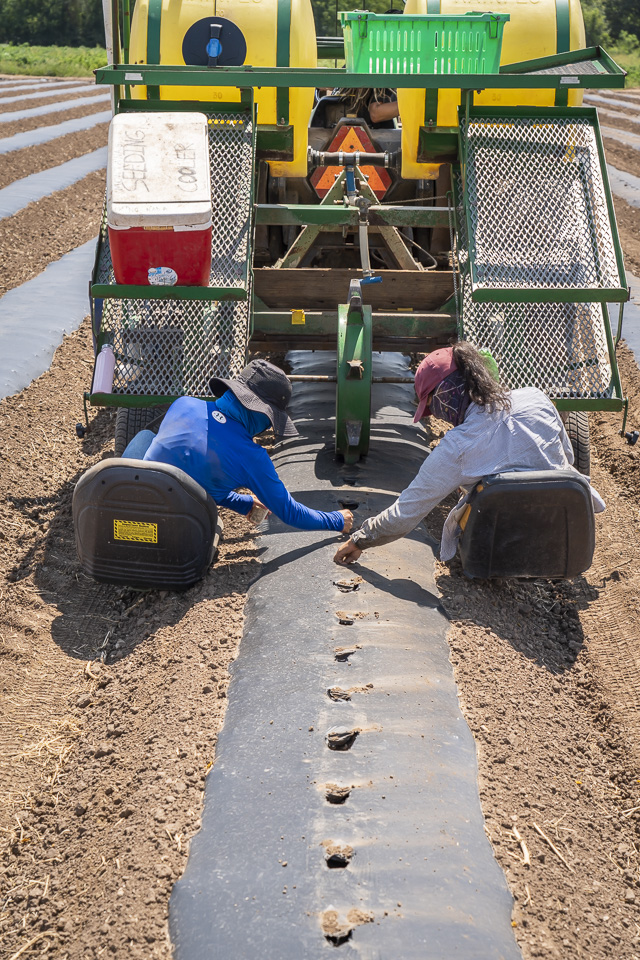 August is a very busy seeding month. Here, to crew members catch a ride on the transplanter to place one individual seed in the whole that was just punched by the wheel in front of them. Photo by Scott David Gordon.
August is a very busy seeding month. Here, to crew members catch a ride on the transplanter to place one individual seed in the whole that was just punched by the wheel in front of them. Photo by Scott David Gordon.
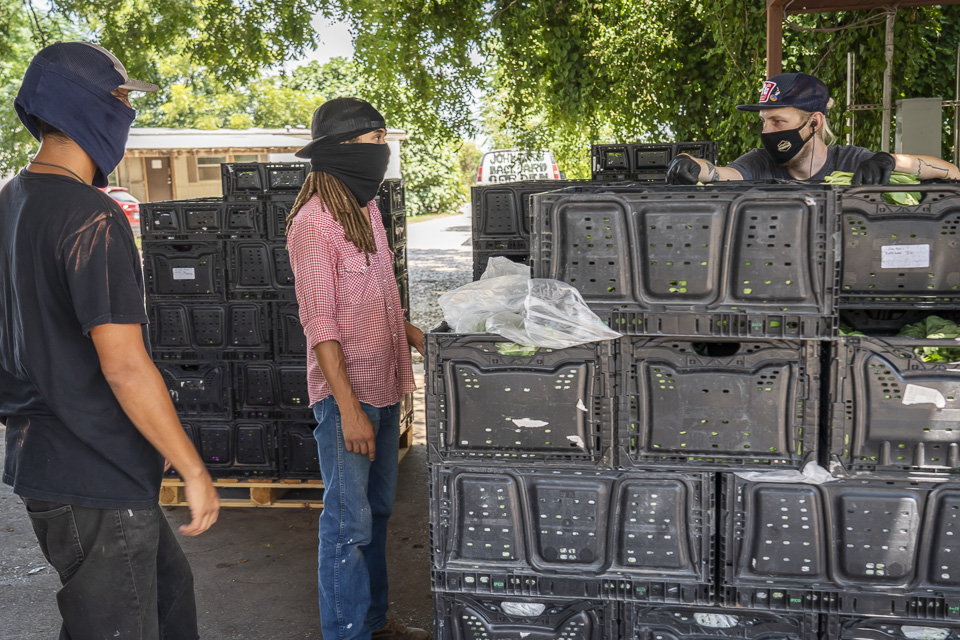 A meeting of the minds: Ricky, Tracy, and Andrew gathered around a harvest of arugula, likely discussing the harvest available for CSA packing for the day, but maybe discussing the current book on their nightstand. Photo by Scott David Gordon.
A meeting of the minds: Ricky, Tracy, and Andrew gathered around a harvest of arugula, likely discussing the harvest available for CSA packing for the day, but maybe discussing the current book on their nightstand. Photo by Scott David Gordon.
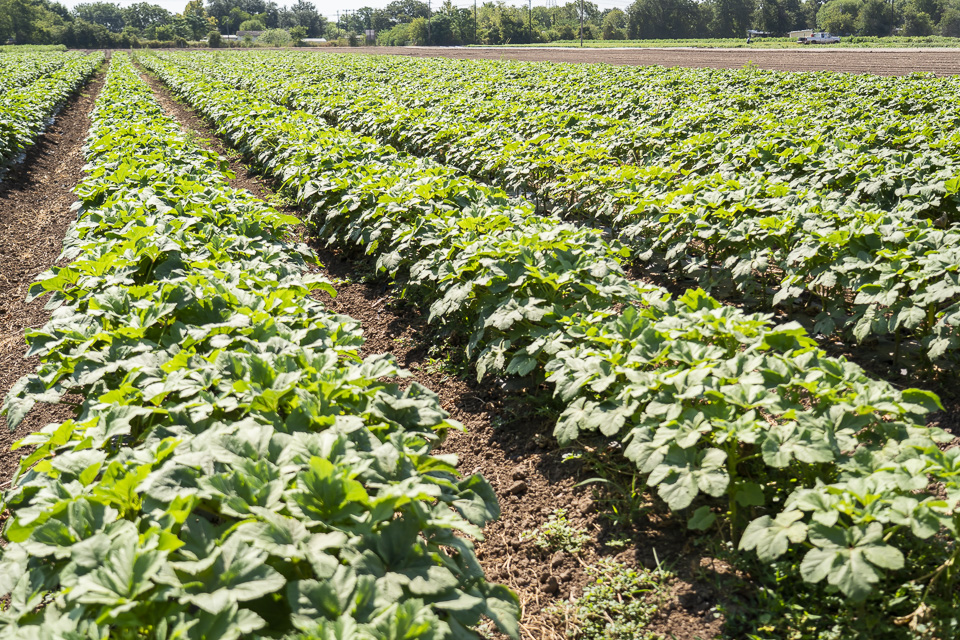 Healthy and vibrant squash plants, ready to transition us to fall Photo by Scott David Gordon.
Healthy and vibrant squash plants, ready to transition us to fall Photo by Scott David Gordon.
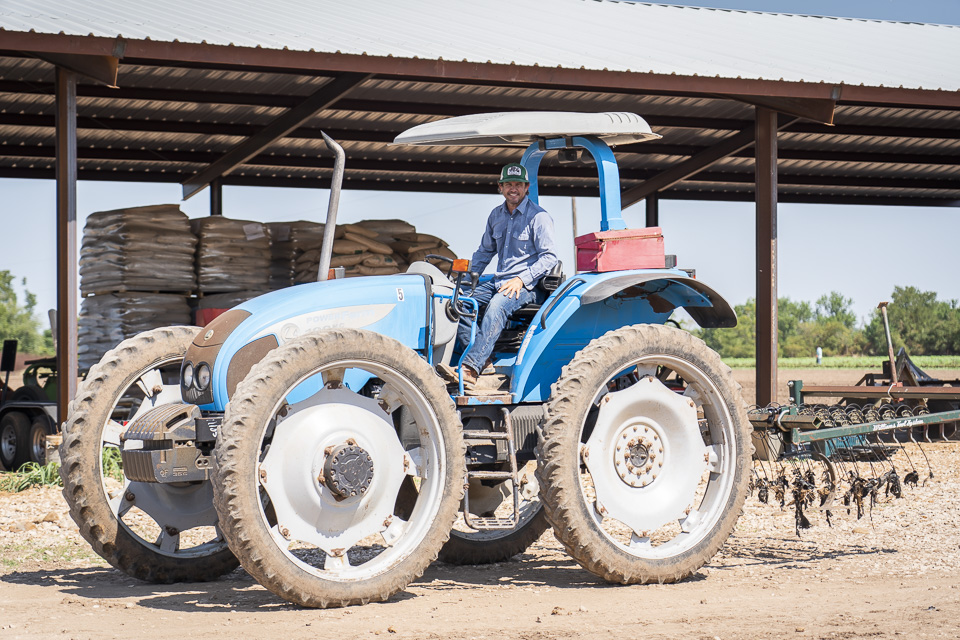 Farmer Brenton cheesing on the Landini, one of the farm's high-crop tractors, with wheels so high it can drive over rows of crops without damaging them! Photo by Scott David Gordon.
Farmer Brenton cheesing on the Landini, one of the farm's high-crop tractors, with wheels so high it can drive over rows of crops without damaging them! Photo by Scott David Gordon.
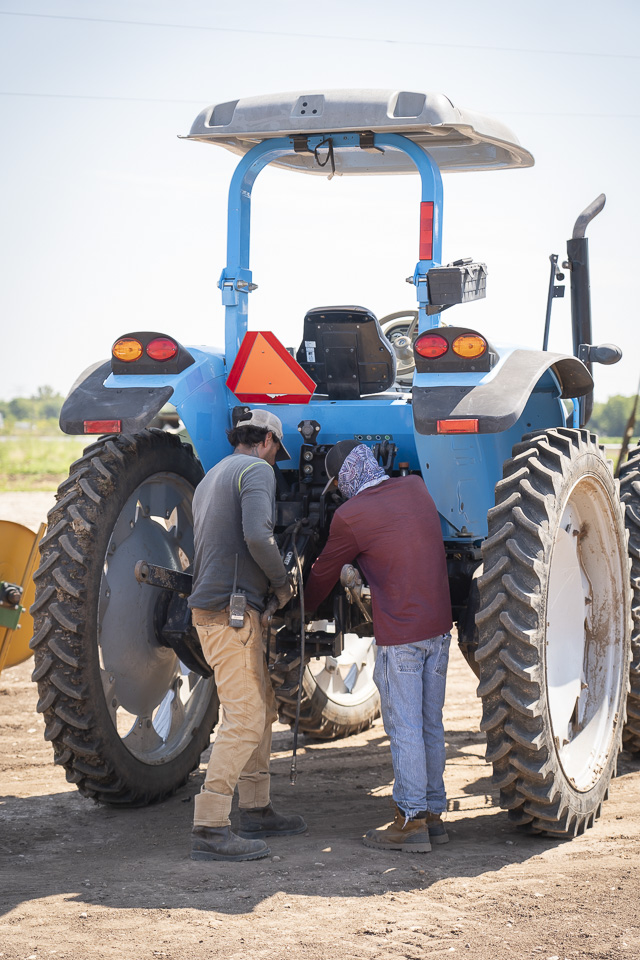 Is there any job where you're required to troubleshoot more often? Photo by Scott David Gordon.
Is there any job where you're required to troubleshoot more often? Photo by Scott David Gordon.
 Old vans and trucks, hand-painted with love for time on the highway and now spending their retirement in a more pastoral setting. Photo by Scott David Gordon.
Old vans and trucks, hand-painted with love for time on the highway and now spending their retirement in a more pastoral setting. Photo by Scott David Gordon.
 Photo by Scott David Gordon.
Photo by Scott David Gordon.
 A freshly sprayed loading dock is a beautiful thing. Photo by Scott David Gordon.
A freshly sprayed loading dock is a beautiful thing. Photo by Scott David Gordon.
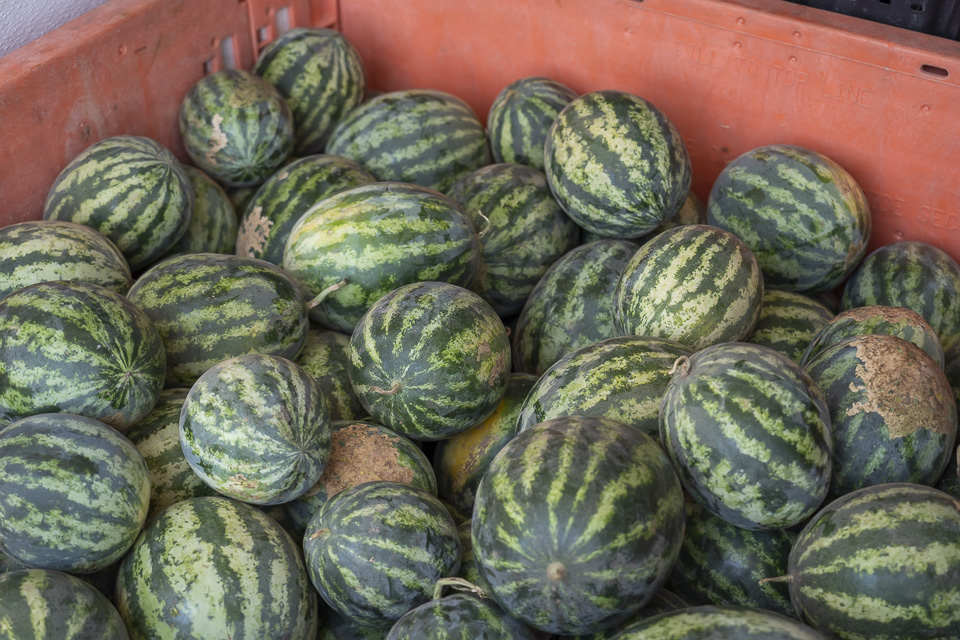 More. Watermelon. Augua fresca, anyone? Photo by Scott David Gordon.
More. Watermelon. Augua fresca, anyone? Photo by Scott David Gordon.
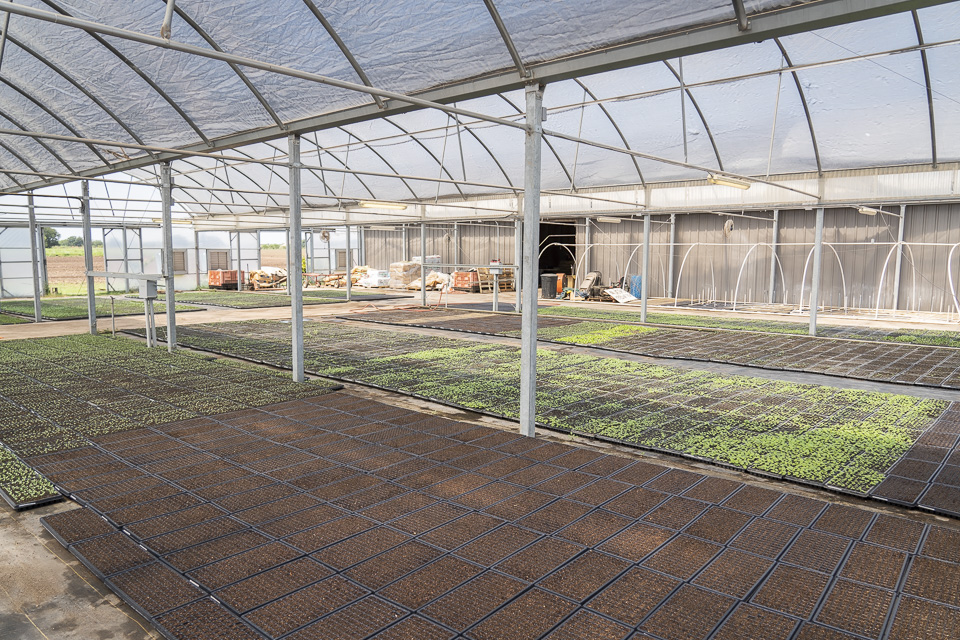 The inside of our greenhouse is reaching capacity. Fall crops are coming! Photo by Scott David Gordon.
The inside of our greenhouse is reaching capacity. Fall crops are coming! Photo by Scott David Gordon.
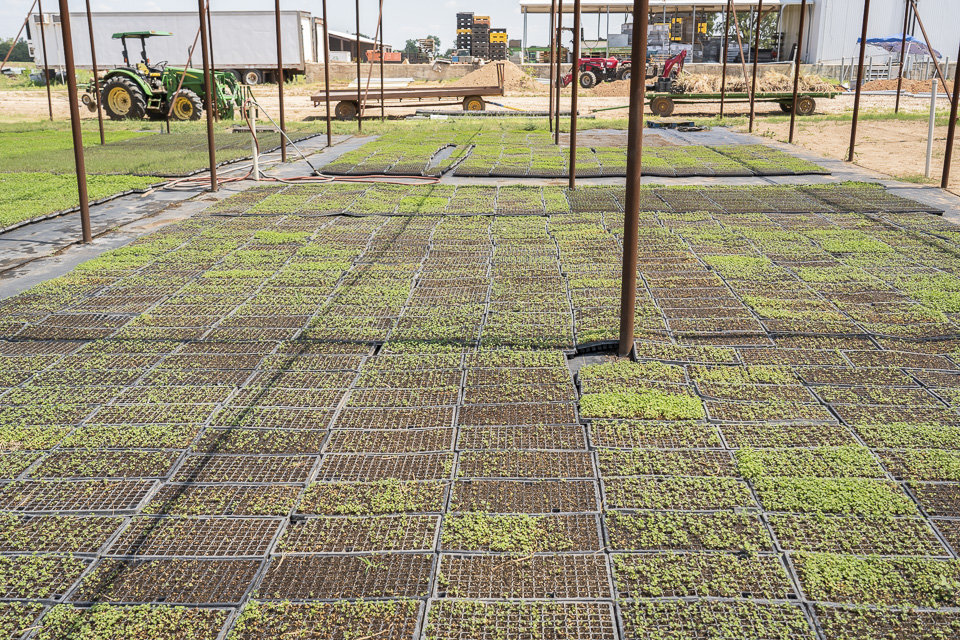 Outside, we have an area that we call "the shade structure". Here, shade cloth is stretched above these metal poles, providing a cooler environment for even more fall transplants. Photo by Scott David Gordon.
Outside, we have an area that we call "the shade structure". Here, shade cloth is stretched above these metal poles, providing a cooler environment for even more fall transplants. Photo by Scott David Gordon.
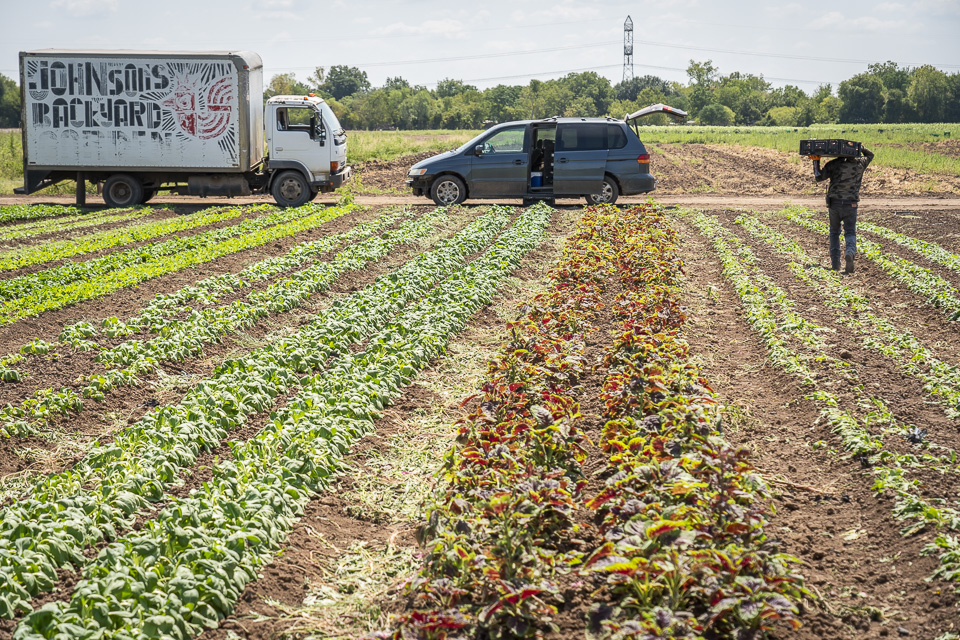 If farm vehicles could talk... Photo by Scott David Gordon.
If farm vehicles could talk... Photo by Scott David Gordon.






 0 ITEMS IN CART
0 ITEMS IN CART 

